Shared posts
Raspberry Pi Drives Holographic Anime Virtual Assistant
Audio-Technica announces ATH-TWX9 auto-sterilising earbuds

Audio-Technica has announced the ATH-TWX9, a set of true wireless earbuds with a unique auto-sterilising feature.
The ATH-TWX9 are premium in-ear headphones with five ANC presets, six hours of continuous playback, a case providing up to 18.5 hours of extended use and wireless charging, and what Audio-Technica describes as an “IPX4-equivalent splashproof rating”.
That’s not what sets the ATH-TWX9 apart from the crowd, however. That would be the deep-UV sterilisation system built directly into the case. Whenever you place the earbuds in the case, a 70-second sterilisation process begins, with mirrors employed to distribute the light evenly.
Audio-Technica claims that the sterilisation process eliminates bacteria and viruses from the surface of the earbuds.
In terms of audio output, the ATH-TWX9 features 5.8mm drivers and supports Sony’s 360 Reality Audio for a realistic 3D sound stage. Supported codecs include Qualcomm’s aptX Adaptive audio.
Call quality is boosted by Sidetone circuitry that lets you hear your own voice in the headphones, which is compatible with most smartphones.
Audio-Technica’s new earbuds also support multipoint pairing, so you can remain connected to two Bluetooth devices simultaneously.
The ATH-TWX9 go on sale on the Audio-Technica website today, November 9, for a premium price of £279.99/€319. There’s just a single colour, called Japanese Black, which works in some classy bronze accents. They come with 12 different fitting eartips, which come in four diameter sizes and three stem lengths.
It’ll be interesting to see if Audio-Technica’s unusually clean in-ear headphones are worthy to join our Best Wireless Earbuds 2022 list.
You might like…
The post Audio-Technica announces ATH-TWX9 auto-sterilising earbuds appeared first on Trusted Reviews.
The Sandman season 2 is no longer a dream for Netflix fans
It's time for fans of The Sandman to stop dreaming – Netflix has officially renewed its TV adaptation of the hit comic series for a second season.
After months of deliberation, Netflix has given Neil Gaiman, Allan Heinberg, and company the go-ahead to make another season of The Sandman. The announcement was made on Twitter on November 2, just hours after a now-deleted tweet from DC Comics all-but-confirmed that the fantasy Netflix series would be returning to our screens (and our dreams).
Yes, it’s true: The Sandman will return to NetflixSays @neilhimself: “There are some astonishing stories waiting for Morpheus and the rest of them…Now it’s time to get back to work. There’s a family meal ahead, after all. And Lucifer is waiting for Morpheus to return to Hell” pic.twitter.com/WKiWp7IDkkNovember 3, 2022
In a press release, Neil Gaiman – The Sandman's original creator and executive producer on Netflix's adaptation – expressed his delight over the show's renewal before teasing what fans can expect from the series' next entry.
"Millions upon millions of people have welcomed, watched and loved The Sandman on Netflix," he said. "From established Sandman fans to people who were simply curious, and then became obsessed with the Lord of Dreams, his family and their goings-on. It gives me unbelievable pleasure to say that, working with Netflix and Warner Bros., Allan Heinberg, David Goyer and I will be bringing even more of The Sandman stories to life.
"There are some astonishing stories waiting for Morpheus and the rest of them (not to mention more members of the Endless Family to meet). Nobody is going to be happier about this than the Sandman cast and crew: they are the biggest Sandman fans there are. And now it's time to get back to work. There's a family meal ahead, after all. And Lucifer is waiting for Morpheus to return to Hell…"
The rumours are true. Netflix is thrilled that so many of you have been watching Sandman, and the thing we were all hoping would happen... has indeed happened... pic.twitter.com/zc5CrhsdZKNovember 3, 2022
Understandably, there's no release date for The Sandman season 2 yet, nor has Netflix confirmed how many episodes the next season will contain. However, the streaming giant hinted that the fictional world Gaiman created will "continue to expand", suggesting that there may be spin-offs and more one-off episodic specials – such as season 1's secret 11th entry – to come.
It's unclear which comic books The Sandman's second season will pull from, too, but Netflix teased that its popular TV adaptation will "return with even more episodes and stories to be adapted from multiple The Sandman graphic novels". Showrunner Allan Heinberg previously confirmed that season 2 would heavily draw from the fourth graphic novel, aka Season of Mists. However, given that The Sandman season 1 comprised stories from the first three volumes in Gaiman's seminal works, the show's next outing is sure to pull from other books, including A Game of You or Fables and Reflections.
Analysis: a nightmare scenario no more
The Sandman season 1 was released on August 5 and quickly became one of Netflix's hottest properties of 2022. The show was streamed for almost 70 million hours in the first few days post-release, and gained further traction in its first two weeks with more than 200 million hours streamed by August 21. It took a whole month for The Sandman's first season to officially drop out of Netflix's Top 10 most popular TV shows list – proof that Netflix's global fanbase was enthralled with Morpheus and company.
It's unsurprising, then, that many clamored for Netflix to renew the series for another outing. Despite its evident popularity, though, fans of The Sandman were made to wait almost three months – from the show's initial release – for the streaming company to greenlight another season.
With every passing week, viewers became increasingly concerned about the prospects of a second season. And it's easy to see why – Netflix has had a habit for canceling some of its most beloved shows before their time is up, regardless of how well they performed. Add in the pricey production costs of The Sandman – Gaiman himself said it was a "really expensive show" to make – and a second season was never a formality.
Still, the nightmarish wait for news on The Sandman season 2 is finally over. If nothing else, we'll be getting another batch of episodes, and that's great news. In our review of The Sandman season 1, we said the series was "oh-so-nearly brilliant", so we're excited to see how Gaiman, Netflix, and company can make its next season even better.
For more Netflix-based content, check out our exclusive interview feature with The Sandman's cast, Gaiman, and Heinberg. Alternatively, read up on the best Netflix movies and best Netflix documentaries around.
God Of War Ragnarok Video Features Ben Stiller Channeling His Inner Kratos
God of War Ragnarok launches in a week, and to celebrate, Sony is counting down the days to its epic Nordic adventure with some family bonding. In a new trailer, Hollywood stars Ben Stiller, John Travolta, and basketball legend LeBron James sit down with their kids to discuss the relationship challenges facing Kratos and Atreus in their latest adventure, while also finding some common ground with the father-son duo.
A LeBreakthrough is had, Stiller looks naturally comfortable in his therapy armor, and Travolta recounts a thrilling tale of spilled salsa that ruined his armor, in his best performance since The Fanatic.
"Putting on the Kratos beard and makeup felt very empowering," Stiller said in a PS Blog post. "The war paint really is useful in terms of letting people know you mean business. I found the beard made me feel wiser…though [my son] Quin didn’t seem to feel that at all."
Continue Reading at GameSpotThe Witcher: How CD Projekt Red Created One of the Biggest Names in Gaming
CD Projekt Red may now have more than 800 developers working across some of the biggest names in RPGs, but when it first began work on The Witcher – which was released 15 years ago this week – it had none of that. It was known for distributing games in Poland, not developing, and very few outside of the country had heard of it or its new project, a dark fantasy RPG based on a series of novels and short stories.
What CD Projekt Red did have was ambition, and despite not knowing at times if it would even complete development on the original game, the team had already planned a trilogy of Witcher titles that would eventually make the game a household name. It’s almost as if a studio with no experience announced a trilogy of Lord of the Rings games, promising gameplay and a narrative as epic as Tolkien’s original. CD Projekt Red proved any naysayers wrong.
Following the announcement that 2007’s The Witcher is being remade in Unreal Engine 5, IGN looks back at the franchise’s beginnings to see what made it successful in the first place.
The Witcher Beginnings: A Crazy Plan
It's not that the CD Projekt Red group knew The Witcher would be successful, of course, as several members of its original team hadn’t created a game before, and none of them had created a game of this size. “We didn't know if the game would be a success or not,” Marcin Blacha, story director at CD Projekt Red, tells IGN. “Of course, we hoped it would appeal to players, but 15 years ago we all had much less experience than we do now, and we found it harder to judge what was right and what was not. Since we all liked RPGs very much, we wanted to be appreciated primarily by fans of this genre.”
Though a love for video games was always at its heart, CD Projekt began as a distribution company that translated English games into Polish. Within a few years it struck up a deal with Bioware and Interplay Entertainment to localise Baldur’s Gate, and it was this relationship that eventually led to the creation of The Witcher.
When Baldur’s Gate: Dark Alliance came around – a new entry only on consoles – the CD Projekt team was concerned. Console gaming wasn’t popular at the time in Poland but Interplay wasn’t making a PC version, meaning the latest version of CD Projekt’s biggest hit was suddenly off limits. The company asked Interplay to consider a PC version, and it did, telling CD Projekt to make it itself. Though the project was cancelled within a couple of months due to financial issues on Interplay’s side, CD Projekt had received the push it needed to consider pursuing game development.
A dedicated studio was founded – CD Projekt Red – and it began looking for an IP that it could turn into a video game. The idea was to bring in an established setting as something to lean on for the novice team. The Witcher and its author Andrzej Sapkowski were just as beloved as J.R.R. Tolkien in Poland, perhaps more so, and the books’ wandering, monster-killing protagonist was the perfect centrepiece for a video game.
“The team that made up the first Witcher game consisted of fans of Sapkowski's stories and novels,” says Blacha. “On the one hand, it gave us an advantage because we felt at ease creating a game with well-known characters in a well-known world. On the other hand, we felt pressure because we wanted our game to be liked by players as much as we liked Sapkowski's books.
“At that time, the source of financing for the game was the publishing part of CD Projekt, so we, working in the development arm, felt like a small experimental group implementing a crazy plan, for which stable and sensible people were earning money.”
“We felt like a small experimental group implementing a crazy plan, for which stable and sensible people were earning money.”While he’s now synonymous with the franchise – brought even further into mainstream consciousness through Henry Cavill’s portrayal in the Netflix series – protagonist Geralt proved to be one of the most complicated inclusions early on (and was almost left out completely). CD Projekt Red built the game around another character called Berengar, who still appears as a NPC in The Witcher, as the team thought the player would feel restricted playing as a pre-established character.
“During the production of the game, however, we changed our minds,” says Blacha. “Geralt was too good to leave out.”
Designing him was another issue, as everyone familiar with the books had imagined Geralt in a different way.
“Working on a main character means that pretty much everyone at the company thinks they know best about how the character should look, and it’s impossible to please even half of your co-workers,” Paweł Mielniczuk tells IGN, an artist on the original Witcher who’s now art director of Cyberpunk 2077’s Phantom Liberty expansion.
A Prototype and an E3
Around a year into development on The Witcher, CD Projekt Red put together a prototype and used the company's distribution contacts to present it to various publishers. The response was not positive, forcing the team to essentially reset production. One old contact did come through later, however, as Bioware licensed out its Aurora Engine (used for Neverwinter Nights) and gave CD Projekt Red another chance.
Another year and yet another prototype later, Bioware asked CD Projekt Red if it wanted to show The Witcher at its E3 booth in 2004, though the team would have to prove their worth. Though all it had was a proof of concept demo that didn’t even have Geralt as the main character, CD Projekt Red presented The Witcher to Bioware.
“We were totally unknown as a developer. No track record, nothing,” said co-founder and CEO Marcin Iwiński in a recent developer interview. “And suddenly the gods of RPGs invite us to show them the stuff. The build was crashy as hell, and we were super stressed because if we showed it and they said, ‘You should work more on this,’ then I think we’re done. I think we just abandon everything. It will be the end.”
It was not the end, of course, as Bioware liked what they saw.
“Tucked away in the Bioware booth in the back of West Hall was one of the true surprises of the show: The Witcher,” IGN said at the time. “While this year's show was full of sequels and not many surprises, Bioware actually pulled a fast one on us.”
CD Projekt Red and The Witcher had been introduced to the world.
Development continued for the next few years without too many issues, though some elements of the game had to be cut back as CD Projekt Red’s ambition outweighed its resources. “None of us had worked on a game of this size and complexity before, and it quickly turned out that our plans were too ambitious,” says Blacha. “The game’s plot had to be much shorter than we originally assumed, so we rewrote the plot of individual parts of the game, but also added more choices and consequences. Many times we thought that we would not be able to finish this project in a reasonable time, but thanks to passion and sheer determination, we did it.”
Release Day
The Witcher was finally released on October 26, 2007, and was received positively by critics. “The Witcher really is a good game and one that PC RPG fans will surely enjoy,” IGN said in our review. “It combines some entertaining and fast-paced combat with a well realized world and pretty decent story that branches and can end in three different fashions.”
It sold well throughout Europe too as CD Projekt Red intended. “At the time, the fact that the game was released only on PC, and that it gained popularity mainly in Europe, wasn’t a bad thing for us,” Blacha says. “We were thinking more locally. It was really important to us that we had completed a large project and built the largest development studio in Poland at the same time.”
It did go almost unnoticed in the United States, however, something that came as a surprise to Iwiński, who also told the story of his visit to New York just after The Witcher launched. “I went to a couple of GameStops and I was expecting a wall of Witcher or something, [and then] I was looking for ‘W’ down on the floor and I couldn’t find it," Iwiński says in the developer interview. He asked a staff member but they hadn’t even heard of it, and he later found out that Atari, who had collaborated with CD Projekt Red to publish the game, just didn’t have the budget for a major U.S. launch.
The Witcher was also a completely unknown franchise, as Sapkowski’s first book wouldn’t arrive stateside until a year after the game in 2008. This was also long before the Netflix show, Dark Horse Comics series, or anything else.
“Our debut was flawed,” says Blacha, who admitted the game wasn’t quite up to the standard that CD Projekt Red wanted. “We were happy with finishing the project but still wanted to improve upon it.”
So the CD Projekt Red team did just that. “We largely re-edited the English translation of The Witcher and re-recorded many lines of dialogue. We also worked on additional content for the game and created DLC offering a new adventure. All of these tweaks, big and small, contributed to The Witcher: Enhanced Edition, which gave the game a second life.”
This capitalised on a steadily growing popularity, as more and more people were playing the game after hearing good things. The Witcher actually wound up selling better in its second quarter than its first.
Sequels and Consoles
CD Projekt Red was ready for true global success and launched two projects in an attempt to achieve it. The Witcher 2: Assassins of Kings would capitalise on the success of the first game with upgrades across the board when released in 2011, while a console version of the original announced one year later would open it up to new markets. The former was incredibly successful, and the latter a complete disaster.
CD Projekt Red outsourced development of a console version of the first game, called The Witcher: Rise of the White Wolf, to French studio Widescreen Games. Problems immediately arose, with the developer requiring regular help from CD Projekt Red, and as the game was outsourced because the developer couldn’t handle two projects to begin with, this became an issue.
The console version was eventually scrapped, but not before CD Projekt Red had poured millions of Atari-funded dollars into it. Unsurprisingly the publisher wanted its investment back, and facing a bill it frankly couldn’t afford, CD Projekt Red signed over The Witcher 2’s publishing rights in North America to Atari to make up its debt.
Though it was a tough time for CD Projekt Red, the developer moved on and eventually released the second game in 2011. “The Witcher 2 was our first real AAA game that was able to reach a lot of players, thanks to a combination of great visuals, music, voice acting, decent combat, and a fascinating story from a very unique world,” says Paweł Sasko, a quest designer on The Witcher 2 and currently Cyberpunk 2077’s quest director. “It was our first attempt to really produce a global hit, reaching far beyond just Polish gamers, and to attract people who didn't know the books by Andrzej Sapkowski.”
It was also well received, and thanks to these upgrades and an Xbox 360 version, CD Projekt Red had succeeded in expanding its presence across the world. “That goal was achieved well enough to give us resources and fuel to build The Witcher 3: Wild Hunt,” says Sasko, “a game that for the first time attempted to be truly open, with an immersive story, believable world, and hundreds of hours of playtime.
"When development started in 2012 we didn't know how to build a game with a very strong story and characters in a completely open setting yet, because nobody had done it at that point. We all knew the Elder Scrolls series and loved those games, but we aspired to tell a story as captivating as the two previous Witcher games.”
The Crowning Achievement
Creating such a game wasn’t easy, especially when CD Projekt Red planned to retire Geralt as The Witcher’s protagonist. “After 10 years and three installments of games about the Witcher, not counting the expansions, we treated Geralt as an old friend,” says Blacha. “On the other hand, during the production of The Witcher 3, we felt that we needed a break from him. When creating its second expansion Blood and Wine, we knew that Geralt would retire and we decided to send him to a warm and pleasant place where he would be taking care of vines and resting on his porch."
Geralt’s last hurrah had to be done in style, of course, so for The Witcher 3 CD Projekt Red finally brought in arguably the second and third most important characters in the Witcher world: Yennefer and Ciri. Both were meticulously created, with Mielniczuk saying the team spent a year crafting the former based on Polish model Klaudia Wróbel before scrapping what they had and starting over. “We made the decision to move away from what we’d scanned and instead focus on modelling something that better reflected Yennefer’s character,” Mielniczuk says. “I recall slowly chiselling away at Ciri’s face for almost three years.”
Introducing these characters allowed CD Projekt Red to reach a new level of storytelling as it was immediately able to build on Geralt, Yennefer, and Ciri’s relationship that was so beloved in Sapkowski’s books.
“Once we knew that we had Ciri and Yennefer in the game, solving many problems was easy because this triangle of characters worked perfectly in the books and could easily be transplanted to become a vehicle for interesting stories in the game,” says Blacha. “By the time we'd finished production of The Witcher 3, it turned out that games had started to explore telling stories that focus on paternal relationships, and at this stage we were already very pleased with Ciri as a character and her role in the game's plot. We knew that we were doing the Geralt-Ciri duo well.”
The Witcher 3 launched in 2015 to the highest praise CD Projekt Red had ever received. “Massive in size, and meticulously detailed, The Witcher 3 ends Geralt's story on a high note,” we said in our review. It would go on to win IGN’s Game of the Year Award later that year. CD Projekt Red and The Witcher had become major names in the video game industry, spawning myriad offshoots including a card game, comic book series, manga, cook book, and more. And though it’s not technically connected to the games, it’s hard not to imagine that their popularity made Netflix pay attention to the franchise ahead of its adaptations, which as of now totals two different shows and an animated film.
Though thought to be finished following The Witcher 3, the video game world is also far from over for the franchise. Not only is the original Witcher being remade but CD Projekt Red announced earlier this month that it has plans for at least four other new Witcher games, headlined by another trilogy featuring a new (but perhaps familiar) protagonist. Ahead of this new era though, Blacha reflects on what he and his team have accomplished.
“It gives me pleasure to think about the vineyard in Toussaint,” he says, “because Geralt was a good companion on a long journey, during which I learned how to make games and had the opportunity to be a co-creator on one of the best video games and most recognizable franchises in the world.”
Ryan Dinsdale is an IGN freelancer. He'll talk about The Witcher all day.
Elon Musk Walks Into Twitter HQ Carrying a Sink
Elon Musk's purchase of Twitter may now be complete after the Tesla CEO walked into its HQ with a sink, captioned with the joke: "Let that sink in."
Musk also updated his Twitter bio to say "chief twit" alongside publishing the short clip of himself (below) walking into the building carrying a porcelain white sink.
He also replied to himself, saying he's "meeting a lot of cool people at Twitter today", again suggesting that his forced $44 billion buyout of the social media giant has been completed. Not completing the deal by October 28 would force Musk to go to trial as a result of his committing and then backing out of the purchase.
Entering Twitter HQ – let that sink in! pic.twitter.com/D68z4K2wq7
— Elon Musk (@elonmusk) October 26, 2022
Some of these "cool people" may be about to lose their jobs, however, as Musk reportedly plans to cut 5,500 jobs - nearly 75% of its workforce - in a move that has some worried about the social media giant's ability to prevent security crises and control harmful content.
Cuts were expected regardless, which is perhaps why Twitter was so eager to receive Musk's offer in the first place, but an expert called the extent of layoffs "unimaginable", saying it would put users at risk of being hacked and exposed to offensive content.
Image credit: JIM WATSON/AFP via Getty Images
Ryan Dinsdale is an IGN freelancer. He'll talk about The Witcher all day.
Lenovo Showcases Concept Laptop With Rollable Display
Tom Cruise's Space Movie Will Include Him Doing an Actual Spacewalk
Mission Impossible and Top Gun: Maverick star Tom Cruise is set to star in a movie shot in space thanks to a partnership with NASA, and Universal wants to make him the “the first civilian to do a spacewalk outside of the space station.”
In an interview with BBC, Universal Filmed Entertainment Group Chairwoman Donna Langley spoke about the project, which will have Cruise and the rest of the film crew take a rocket to the International Space Station to shoot parts of the movie in space.
Cruise and director Doug Liman pitched the film to Langley over Zoom during the COVID-19 pandemic, and she says the movie's overarching plot "actually takes place on Earth, and then the character needs to go up to space to save the day.” Some scenes will include Cruise’s character walking outside of the space station itself, which will give the movie something other movies set in outer space have only been able to emulate.
“Tom Cruise is taking us to space. He’s taking the world to space. That’s the plan,” Langley told BBC. “We have a great project in development with Tom, that does contemplate him doing just that. Taking a rocket up to the space station and shooting and hopefully being the first civilian to do a spacewalk outside of the space station.”
The as-of-yet-unnamed film was announced back in 2020, with Cruise and Limen’s collaboration being a major tentpole of the announcement. Cruise and Limen previously worked together as actor and director on Edge of Tomorrow and American Made.
Kenneth Shepard is a writer covering games, entertainment, and queerness all around the internet. Find him on Twitter at @shepardcdr, and listen to his biweekly video game retrospective podcast Normandy FM, which is currently covering Cyberpunk 2077.
EU votes in favor of making USB-C a requirement, and all eyes are on the iPhone
Dune: The Sisterhood: Emily Watson And Shirley Henderson Will Star In The HBO Max Series
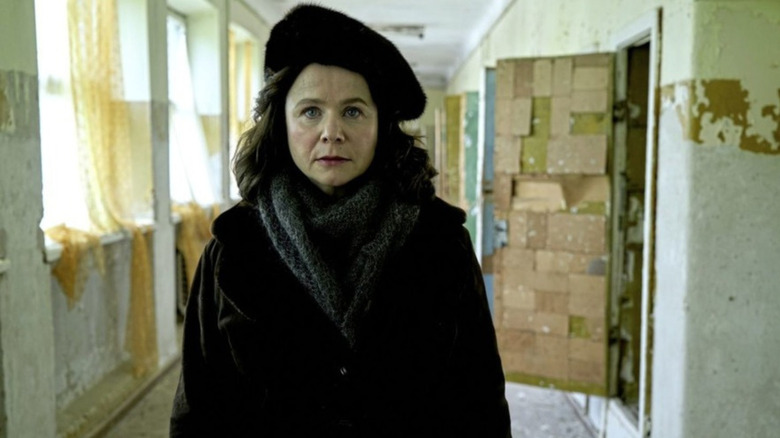
After what felt like ages since we last heard about this series, we finally have our two leads for "Dune: The Sisterhood." The prequel series to Denis Villeneuve's adaptation of "Dune" will star Emily Watson and Shirley Henderson, with them portraying Valya and Tula Harkonnen respectively.
If those names sound familiar to you, then you likely know your "Dune" lore. However, for newbies who were introduced to Frank Herbert's world through last year's film, here's a brief rundown. Valya and Tula are sisters who end up becoming a part of an underground organization called the Sisterhood of Rossak. First introduced in the 2012 novel "Sisterhood of Dune" by Herbert's son Brian Herbert, this organization would eventually evolve into the Bene Gesserit, which featured prominently in the original "Dune" novels as well as Villeneuve's adaptation.
Fear Is The Mind-Killer
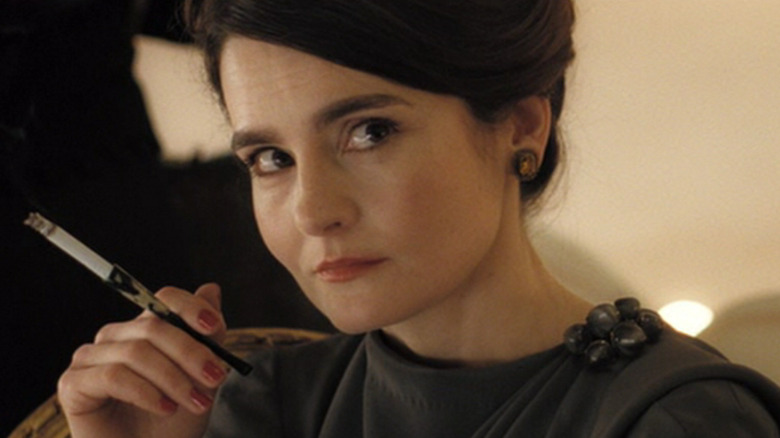
Given how long it has been since we received news on this series, we wouldn't blame you if you thought it was among the many projects canceled by Warner Bros. Discovery earlier this year. Some of us here at /Film thought the same! Thankfully, this certainly doesn't look to be the case, especially with Watson and Henderson slated to star.
Diane Ademu-John, who helped write and produce episodes of "The Haunting of Bly Manor" and "Medium," will serve as the series showrunner. Villeneuve will serve as an executive producer as he films the upcoming sequel "Dune: Part Two." The aforementioned Brian Herbert and his daughter Kim will also produce alongside Jon Spaihts, Scott Z. Burns, Cait Collins, John Cameron, Matthew King, and Byron Merritt.
Not much is known about the series and whether it will be a faithful adaptation of "Sisterhood of Dune." However, Variety reports that the official logline says it will follow "the Harkonnen Sisters as they combat forces that threaten the future of humankind, and establish the fabled sect known as the Bene Gesserit." What these forces are, though, and whether they will be any different from the anti-computer extremists from 2012 still remains to be seen.
"Dune: The Sisterhood" does not yet have a tentative release date, but "Dune: Part Two" is expected to arrive in theaters on November 17, 2023.
Read this next: The Most Controversial Scenes In Sci-Fi Movies
The post Dune: The Sisterhood: Emily Watson and Shirley Henderson Will Star in the HBO Max Series appeared first on /Film.
What Can The Rings Of Power Adapt? A Guide To The Lord Of The Rings' Rights Issues
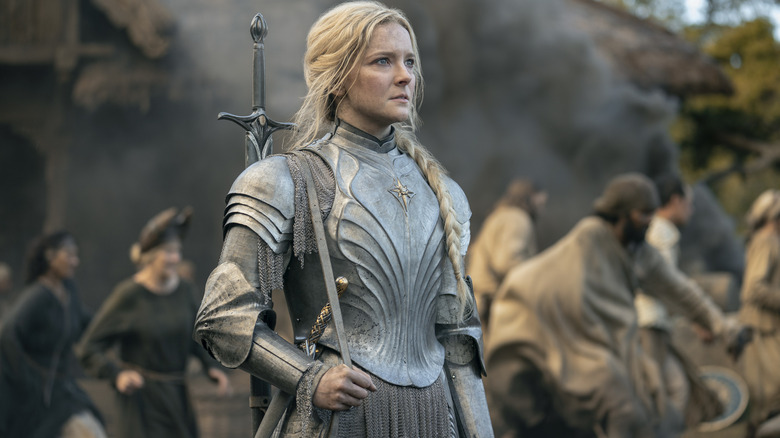
Warriors have their swords, wizards have their walking sticks, and harfoots have their, well, hairy feet. But for those of us on the outside looking in at fantastical shows like "The Lord of the Rings: The Rings of Power," we may have nothing but questions about how exactly this sprawling story in season 1 came together to begin with. The endless handwringing over fidelity to author J.R.R. Tolkien's work and whether this story truly "feels like Tolkien" enough have driven plenty of headlines, but there may remain some confusion over just what source material "The Rings of Power" is adapting in the first place and how exactly this new story is meant to fit into the vast legendarium.
The short answer? Unlike Peter Jackson's "The Lord of the Rings" (or even other fantasy contemporaries, like the ongoing "House of the Dragon"), series creators J.D. Payne and Patrick McKay didn't have the benefit of any single text to draw upon in order to build out their scripts. More to the point, this show technically exists in a separate continuity altogether from Jackson's acclaimed trilogy of movies — a legal obstacle that makes many of the shared characters, locations, and even designs between "The Lord of the Rings" and "The Rings of Power" that much more complicated. The long answer, then? Well, that would require clearing up the muddied water surrounding most discussions of this fascinating and relatively complicated take on Middle-earth.
So for those who may not know their "Silmarillion" from Sauron — and even for those who do — consider this a handy explainer rounding up all the information we know about "The Lord of the Rings: The Rings of Power," the specific Tolkien writing it's adapting, and how it conquered its toughest foe yet: those pesky rights issues.
What Did Amazon Buy Anyway?
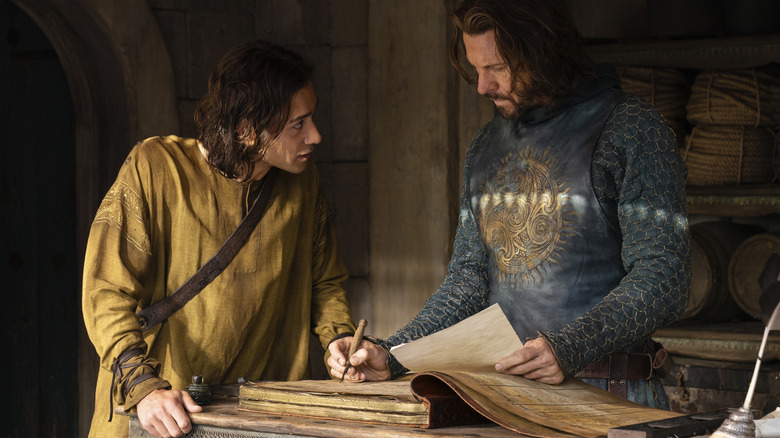
It's the million-dollar question — $250 million, actually. When Amazon Studios first purchased the television rights to create what would eventually become "The Rings of Power," the news inspired hot takes, kneejerk reactions, and no shortage of eyebrow-raising questions.
Hesitant fans immediately wondered what material this show could even adapt in the first place. Such skepticism came from the knowledge that the Tolkien Estate — the notoriously hard-to-please legal entity considered to be custodians and caretakers of Tolkien's legacy — jealously guard the rights to "The Silmarillion" under lock and key, preventing it from being adapted in any form after the Tolkien family felt jilted by the liberties Peter Jackson took with his film trilogy. This meant that the author's golden goose, a veritable treasure trove of epic poems and tales depicting events taking place long before "The Lord of the Rings," remains strictly off-limits.
Instead, Amazon's deal clearly defined the parameters of what could and couldn't be translated to the small screen. To do this, Payne and McKay had to turn to alternative sources. As the showrunners once explained:
"We have the rights solely to 'The Fellowship of the Ring,' 'The Two Towers,' 'The Return of the King,' the appendices, and 'The Hobbit.' And that is it. We do not have the rights to 'The Silmarillion,' 'Unfinished Tales,' 'The History of Middle-earth,' or any of those other books."
So the writers resorted to loopholes: adapting "The Lord of the Rings" chapters where characters reference historical events that took place in the First and Second Ages and, more than anything else, the lengthy appendices included at the end of "The Return of the King" that went into greater detail and provided the basis for "The Rings of Power."
Wait, So The Rings Of Power Isn't A Prequel To The Movies?
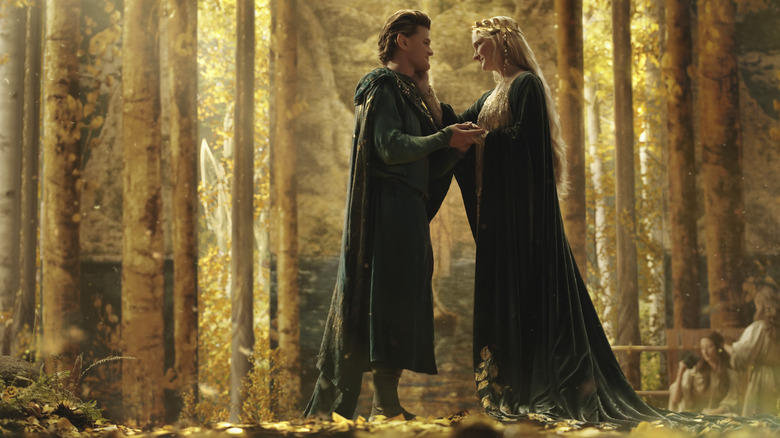
When is a prequel not actually a prequel? When the complicated ins and outs of Tolkien rights come into play.
Despite common misconceptions that "The Rings of Power" and Peter Jackson's groundbreaking "The Lord of the Rings" movies are canonical with one another — understandably so, give several shared characters, many of the same locations, and even certain examples of creature design — "The Rings of Power" is prohibited from existing within the same exact continuity. Unable to contradict or add to anything that Jackson did with his films (which explains why Amazon abruptly backed away from bringing the director on board as a consultant in any capacity whatsoever), the series instead must stand on its own two feet rather than function as a traditional prequel.
Admittedly, this doesn't really affect the viewing experience of "The Rings of Power" all that much since both properties are rooted in the same source material, which means there are ample opportunities for clever retconning.
Familiar characters like Elrond and Galadriel, portrayed by Robert Aramayo and Morfyyd Clark respectively, are known quantities to those who watched Hugo Weaving and Cate Blanchett play different (and much older) versions of those characters in "The Lord of the Rings." The fact that they aren't literally the same heroes we saw before, however, shouldn't make much of a difference to anyone except the biggest lore obsessives. Their characterizations still draw upon how Tolkien originally envisioned them, which means it's fair game to compare their younger selves in the show with how the movies interpreted them much later on in their lives.
The showrunners addressed this as well, citing a mandate of "different but familiar" in taking inspiration from Jackson's Middle-earth without staying beholden to it.
Bending The Rules
After all this talk about how ironclad and constricting this rights situation is for "The Rings of Power," however, it's worth noting that not all aspects of this Amazon deal seem to be as intractable and nigh indestructible as the One Ring itself.
Consider the very glaring fact that, despite taking place in a separate continuity entirely, certain aspects of "The Rings of Power" appear to be pulled straight from Jackson's "The Lord of the Rings" movies. For one thing, the Amazon series brought back artists such as composer Howard Shore, concept artist John Howe, and others who were involved with the original movies, adding more confusion to the proceedings through this shared DNA. But much more noticeably, several character and creature designs — from the look of Sauron himself (as glimpsed briefly early in the premiere) to the fiery balrog to even invoking certain "Silmarillion"-exclusive lore (as noted by Collider) — are exactly as they appear in material outside of Amazon's purview.
How to explain the studio's apparent flouting of their own deal?
Well, consider that the show's creatives worked closely with Tolkien Estate director and Tolkien's own grandson, Simon Tolkien, throughout the process. This unprecedented collaboration, previously unheard-of in the history of the Tolkien Estate and its tumultuous relationship with previous adaptations, almost certainly thawed the frost between both parties and allowed for a relaxing of the rules. This seems to have been alluded to in a recent Variety profile of Amazon Studios head Jennifer Salke, who remarked on Simon Tolkien's work on the series and that "...the estate was very open and encouraging for reinvention, but always in ways that stay true to Tolkien. We all have the same kind of vision for this property. There was never any disconnect there, which is probably why it worked out so well."
This partnership seems to have worked out so far on "The Rings of Power," giving us a thrilling and unique fantasy story that — complicated rights issues and all — should provide even more excitement to come.
Read this next: 13 Fantasy Shows Like The Lord Of The Rings: The Rings Of Power You Should Check Out
The post What Can The Rings of Power Adapt? A Guide to The Lord of the Rings' Rights Issues appeared first on /Film.
She-Hulk episode 7 characters explained: who are Man-Bull, El Aguila, Saracen, and Porcupine?
Potential spoilers for She-Hulk episode 7 follow.
She-Hulk: Attorney at Law episode 7 – The Retreat – has smashed its way onto Disney Plus. And, while viewers are still waiting for Daredevil's arrival in the Marvel Cinematic Universe (MCU) – it's coming, we promise – we were introduced to some new and unusual characters in the Marvel TV show's latest entry.
The MCU Phase 4 project has done a delightful job of introducing minor Marvel characters to a wider audience and She-Hulk episode 7 is no exception. In it, four new individuals are shown to exist in the MCU – Man-Bull, El Aguila, Porcupine, and Saracen.
Who are these characters, though? What do their Marvel comics histories tell us about them? And could we see them crop up in the MCU again?
Below, we'll explain who this new quartet is and whether they'll reappear in the MCU in the Disney Plus show again, in Marvel Phase 5 productions, or even beyond that.
She-Hulk's Man-Bull explained: who is the minotaur-like Marvel character?

A supervillain by trade, Man-Bull is a minotaur-like Marvel character who made his comic debut in July 1971. Interestingly, Man-Bull's first comic book appearance was in Daredevil #78 – another tie into the Man Without Fear's forthcoming appearance in She-Hulk's TV series. He's also crossed paths with Hulk, She-Hulk, and other superheroes in the comics. Additionally, he's run into the anti-hero/supervillain team known as the Thunderbolts, so maybe he'll reappear in the MCU's Thunderbolts movie. It's highly unlikely, but never say never.
Real name William 'Bill' Taurens, Man-Bull acquired his abilities – and his signature horns – after he was used as a guinea pig for an experimental serum derived from bulls. Subsequently, Man-Bull was imbued with traditional superpowers, such as superhuman strength, stamina, durability, and speed. Oh, and he has the ability to empathize with cows. Go figure.
In She-Hulk, he's less animalistic – in his appearance anyway – and comes across as more of a sympathetic villain/anti-hero who is trying to turn his life around. He's played by Nathan Hurd (Legion, Elementary) in the MCU TV show.
She-Hulk's El Aguila explained: who is the Matador-style mutant?

The MCU is slowly starting to build out its roster of mutant superheroes and villains. So far, we know three mutants exist in the MCU, with Ms Marvel, Black Panther: Wakanda Forever anti-hero Namor, and Wolverine – who'll co-star in Deadpool 3 – making up that trio.
El Aguila takes that number to four. In the comics, El Aguila is a human mutant who possesses the ability to generate electricity, as well as being an expert close-quarters combatant and skilled fencer.
Debuting in August 1979, El Aguila was introduced as a morally gray vigilante who aided Iron Fist and Luke Cage – the latter called Power Man at the time – in taking down drug lords and other criminals. However, he's also occasionally operated as an anti-hero, with El Aguila locking horns with Hawkeye during one comic storyline.
Given his matador-like appearance, which was chiefly inspired by Zorro, it's surprising to see El Aguila and Man-Bull form a close bond in She-Hulk episode 7. Still, the pair's unlikely friendship makes for a fun side narrative. El Aguila, whose real name is Alejandro Montoya, is portrayed by Joseph Castillo-Midyett (The Equalizer, Fear The Walking Dead). Don't expect him to appear outside of She-Hulk's show, unless Iron Fist and Luke Cage make their way into the MCU.
She-Hulk's Saracan explained: who is the MCU's first vampire?
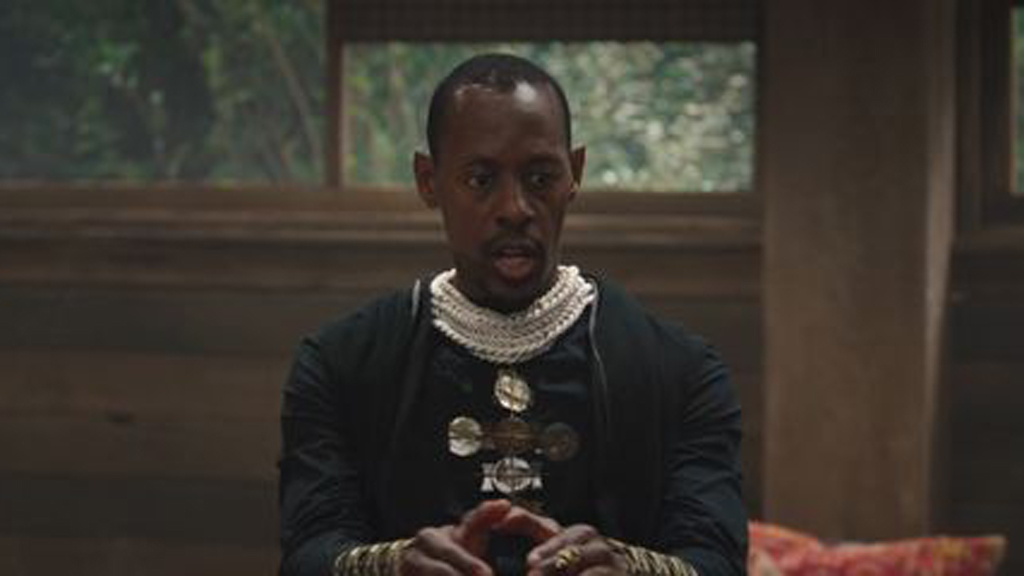
Blade might be the most recognizable vampire in Marvel's superhero/anti-hero roster, but that doesn't mean other bloodsuckers don't exist in the comics or the MCU.
While Marvel Studios' Blade movie is seemingly trapped in development hell, Saracen's appearance in She-Hulk episode 7 means that there's at least one vampire in the MCU. Well, that's if you believe Saracen anyway. The other attendees at Emil Blonsky's meditation retreat don't believe he really is a vampire, but there is evidence in the comics to suggest that he's telling the truth.
The group's confusion likely stems from the fact that there are two Saracen characters in Marvel comics. One of those, who goes by the name Muzzafar Lambert, is a globe-trotting mercenary who has regularly duked it out with The Punisher. The other Saracen, whose name is unknown, made his comic debut in Blade: Vampire Hunter #1 in October 1999. Little is known about this vampiric Saracen, though, outside of the fact that he's one of the most long-lived monsters in Marvel comics history.
It seems that She-Hulk's writers have used the latter for Saracen's first MCU appearance. The Retreat's credits list Terrence Clowe (The Harder They Fall, Dopesick) as playing Saracen, but don't mention Lambert. Unless Marvel has combined the two characters to avoid confusion, it's likely that the vampiric Saracen is the one who turns up in She-Hulk episode 7. Could he make a cameo appearance in Blade? Here's hoping.
She-Hulk's Porcupine explained: who is the masked Marvel character?
Real name Alexander Gentry, Porcupine is a Marvel supervillain who usually clashes with Ant-Man and the Wasp in the comics. He made his literary debut in Tales to Atonish #48 in October 1963, making him one of the oldest Marvel villains ever. Like Man-Bull, he's crossed paths wit the Thunderbolts, so could he show up in that superhero film, too? Again, don't count on it.
A scientist who designed weapons for the US military, Gentry creates a porcupine-style super suit, which has the ability to shoot quills, gases, flames, or chemicals at those who the wearer deems to be a threat. Gentry, though, believes that the US government won't pay him for this creation – a move that sees him keep the suit for himself and uses it to start robbing banks and other establishments.
Two other Marvel characters have also assumed the identity of Porcupine. The first was Billy Bates, another mutant character who first appeared in August 2005's District X #13. Unlike Gentry, Bates is the owner of the X-gene, the DNA strand that grants its host superpowers when they come of age. Unfortunately for Bates, he acquired the abilities of an actual porcupine. He's able to grow and fire porcupine-like quills at his foes, as well as distorting his left arm into a long, deformed limb with serrated claws at his fingertips.
The final person to assume the mantle was Roger Docking, who made his comic debut in May 2006's Daughters of the Dragon #3. He also wore the suit, although his creation had different abilities to Gentry's, such as jet boots for flight purposes and night vision goggles.
Based on his more realistic MCU appearance, it isn't the Bates version of Porcupine who appears in She-Hulk episode 7. Instead, it's either Gentry or Docking. However, The Retreat's credits don't specify which individual this is – we only know Porcupine is played by Jordan Aaron Ford.
For more MCU-based content, check out our Marvel movies in order guide. Alternatively, read up on every She-Hulk post-credits scene so far, or find out who the TV show's main villain could be.
How The Rings of Power episode 6's explosive ending was brought to life
Full spoilers for The Rings of Power episode 6 follow. You've been warned.
The Rings of Power has officially arrived. Sure, the high fantasy Prime Video show actually launched on September 2, but it's needed a hugely significant episode to truly announce itself on the prestige TV stage.
Episode 6 is the epic and explosive entry Amazon's Lord of the Rings TV series and audiences have been waiting for. It's packed with frenetic and fraught set-pieces, tells a story with multiple twists and turns, and culminates in a stunning finale that'll have viewers' jaws on the floor long after the credits roll.
Unsurprisingly, a lot of work went into designing and crafting episode 6's shock ending. And, as co-showrunners Patrick McKay and J.D. Payne told TechRadar at an exclusive preview screening, the episode's final moments were planned as season 1's tentpole moment as far back as 2018.
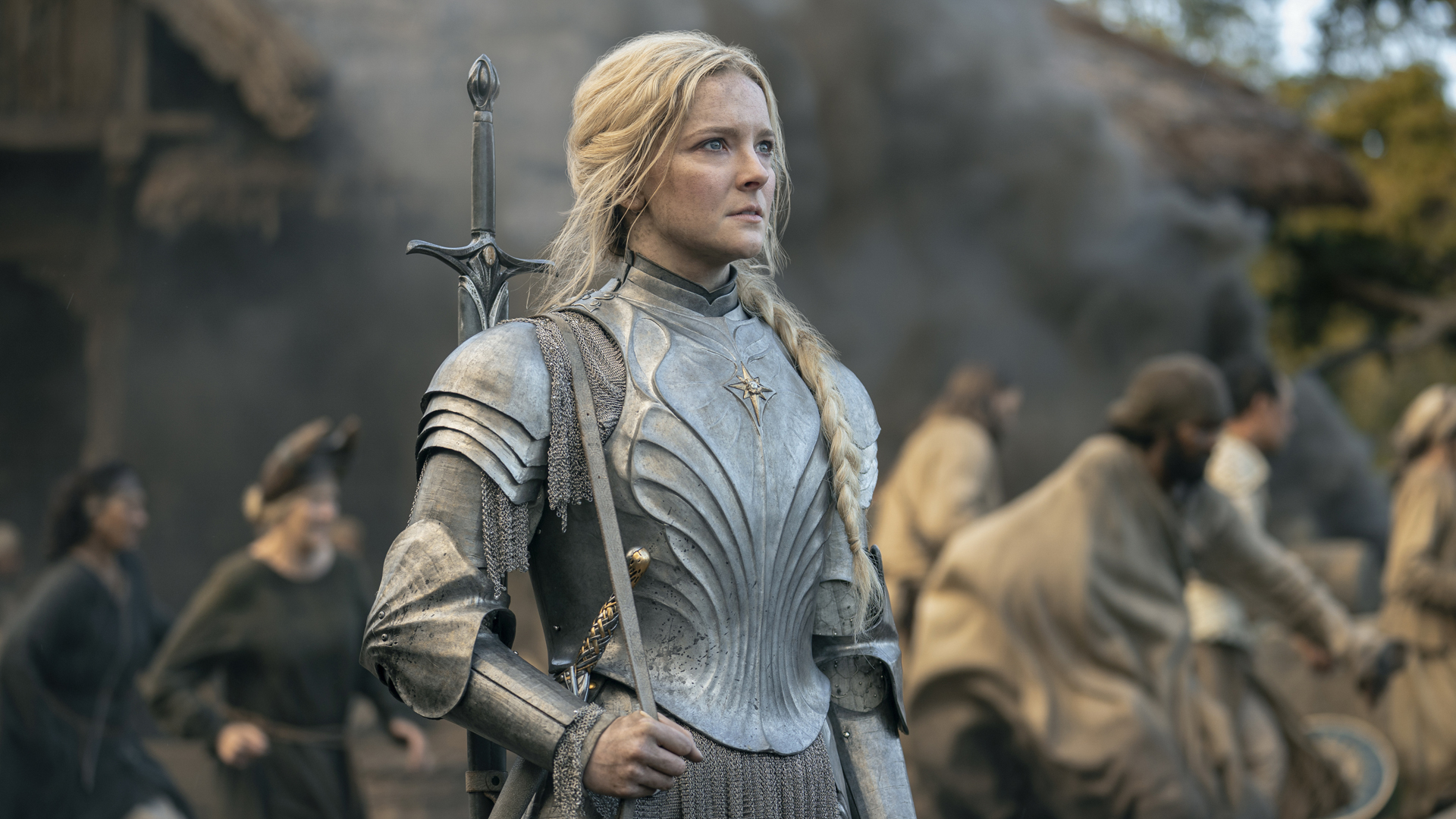
"[It took] four years," McKay says. "We've known about that sequence for that long."
"When we were blocking out season 1, we had a whiteboard of character arcs for Galadriel, Elendil, Isildur, Arondir, Bronwyn – all the main characters in this episode," Payne adds. "All of those journeys were leading to this point when we finally introduce Mordor."
That's right, The Rings of Power episode 6 shows us how Mordor – and its iconic volcano, aka Mount Doom – were ultimately created.
Viewers had already speculated that Mordor's introduction wasn't too far away, with previous season 1 episodes teasing as much. In episode 3, Galadriel and Elendil pour over some old Middle-earth maps, which show that the region known as the Southlands sits right on top of where Mordor exists in J.R.R. Tolkien's Hobbit and Lord of the Rings novels. Adar's orc army is based in this location throughout season 1 – an area where they've dug tunnels and deforested large swathes of land – which had lent further proof to Mordor's eventual arrival.
What audiences didn't expect is that Mordor and Mount Doom would be born this early in the series. However, those familiar with Lord of the Rings' extensive history would've been able to work out that this iconic location would be part of episode 6. Its official title – Udûn – is also the name of a barren valley situated in northwest Mordor, so it wouldn't have taken much for diehard Tolkien fans to make the connection.
Still, for casual Lord of the Rings fans and general audiences, the birth of Mordor and Mount Doom in The Rings of Power is a truly shocking and visually spectacular moment. So, how was the sequence developed?
The eruption of an idea

Udûn's finale was a seismic undertaking for everyone involved in The Rings of Power. The explosive sequence's final edit comprises multiple VFX shots, complete with a huge volcanic eruption, searingly hot rocks raining down from the sky, a storm-fuelled ash cloud, and fires breaking out as the Southlands and its inhabitants are consumed by the cataclysmic event.
Before its visually arresting effects could be added in post, The Rings of Power's chief creative team had to make sure that events preceding the eruption could lead to the mountain – that becomes Mount Doom – violently blowing its top. After all, such a move is only possible via the collision of its vast lava pit with water from Ostilith's deep reservoir. That happens after Southland turncoat Waldreg uses the sword hilt, which Adar reacquires from the Southlanders in episode 6, as a key to unlock part of Ostilith's dam. It's a move that allows a deluge of water to rush through numerous tunnels – dug by the orcs – and snake its way to the ice covered mountain, which becomes Mount Doom.
All of those journeys were leading to this point
J.D. Payne, Rings of Power co-creator
Could a combination of an expansive volume of water and a giant pool of lava, then, cause such an explosive eruption? According to real-world science, yes.
"One of our writers knows a geologist," Payne explains. "So we asked them if water and lava could unite to create this gigantic explosion, and it could. They said 'if you have enough steam pressure that builds up in a confined space, the entropy inside the volcano will increase, eventually causing it to blow."
"We painstakingly studied what actually happens in volcanic eruptions," VFX producer Ron Ames adds. "We looked at photographs and we read historical documents on Pompeii so we had a clearer idea of the scale of these naturally occurring explosions."
Buoyed by the backing of real-life science, The Rings of Power's huge crew set about creating a finale that would herald the show's epic arrival on the world stage. Typical pre-production work, such as concept art, storyboards, and location scouting were carried out well in advance of principal photography. Once those elements were in place, multiple camera crews set out to film external shots – wide and sweeping landscape, as well as close-ups – to use during the sequence.
"It was important to us to use real world locations," Ames reveals. "The actual mountain itself is based on a real location. The cliff that Ostilith sits on is an actual location. We went to those areas and shot backgrounds using helicopters. We also landed in those areas and took photographs and plates. Even the water you see in the final sequence is real – it's just mixed in with some CGI elements to aid the flow of this massive deluge as it careens down the valley."
Heating up in post
With pre-production and principal photography in the can, the lengthy post-production process could begin.
Like many of The Rings of Power's VFX-laden sequences, episode 6's finale was developed by multiple animation studios. Weta Digital, who worked on Peter Jackson's Hobbit and Lord of the Rings movie trilogies, produced the Ostilith cliffside-based portion. Lucasfilm's Industrial Light and Magic (ILM) crafted the underground sequence, which leads to the violent explosion. Meanwhile, Australian-based studio Rising Sun were tasked with creating the post-eruption scene, including the spewed lava rocks and rapidly traveling ash cloud.
"Once all the vendors mixed each part together, you can't tell where one shot starts and another ends," Ames says. "It's all seamlessly connected and I couldn't be more proud of the teams that worked together to compose and knit it together. It's one of my favorite sequences in the whole show."
Crunching has become a hot topic of conversation in the film and TV industries, with big-budget projects – including She-Hulk: Attorney at Law on Disney Plus – and studios coming under fire over employees' working conditions.
We looked at photographs and we read historical documents on Pompeii
Ron Amex, Rings of Power VFX producer
Given the scale of this sequence and 9,500 other VFX-based shots in season 1, it seems inevitable that The Rings of Power's backstage crew would have to crunch at some point. Ames, though, was adamant that no one under his supervision would be forced to work longer – at the cost of their physical and mental wellbeing – to ensure sequences like the Mount Doom one were completed in time.
"Having seen the film business change and being an advocate for technology, I would say mindfulness and and an approach to sharing the load is extremely important," Ames says. "Largely, we didn't work more than 12-hour days. In some instances, I had to send crew members home to sleep and shower – they all worked extremely hard, but everyone got to go home, to see their families, to attend weddings, and do all the things humans need to do. I think the future of filmmaking requires us to look at mindfulness in the workplace and how to move forward in a balanced way to get the most creativity out of our artists."
Udûn's final sequence is a visually striking sight to behold. It's the brainchild of multiple creators and studios, all of whom worked diligently to collaborate on The Rings of Power's most harrowing spectacle to date. "It was ILM VFX supervisor Jason Smith's creation," Ames says, but the countless artists, animators, renderers, and other crew members deserve as much praise for creating such a devastatingly beautiful moment in Middle-earth's history.
With two more episodes to come in season 1 – not to mention four more seasons' worth of storytelling to come – The Rings of Power will contain more shocking, big-budget sequences like episode 6's finale. Right now, though, Udûn is the explosive show-defining entry that the Prime Video series required – and it'll take something truly amazing to usurp it.
The Rings of Power's first six episodes are available to stream on Prime Video now.
Star Wars: Andor Reveals the Divided Factions of the Rebel Alliance
Warning: this article contains spoilers for Star Wars: Andor Episode 4! If you haven't already, be sure to check out our spoiler-free review of the first four episodes.
The original Star Wars trilogy paints the Rebel Alliance as a plucky band of freedom fighters all united in a common cause. And maybe that was true by the time Luke Skywalker strolled in, but it wasn't always the case. Star Wars: Andor is the latest series to reveal just how fractured and divided the Rebellion was in its early years.
With Episode 4 of Andor reintroducing Genevieve O'Reilly's Mon Mothma, now seems like a good time to break down the many factions that formed the Rebellion and why this resistance movement didn't always qualify as an alliance.
Mon Mothma and the Loyalists

Mon Mothma first appeared in Return of the Jedi, by which point she had emerged as the leader and public face of the Alliance to Restore the Republic (as it's officially known). But if there's one takeaway from Mothma's appearances in chronologically earlier projects like Revenge of the Sith, Rogue One and now Andor, it's that she had to spend decades building up the resources and support needed to spearhead a true rebellion.
Andor Episode 4 reveals how difficult that process was in its early stages. We see Mothma meeting with Luthen Rael, who has to press her for the funds to hire Cassian into his group of undercover spies. Alongside her ally Bail Organa, Mothma is responsible for bankrolling the early Rebellion. And while Imperial senators may have a level of wealth that most ordinary people would struggle to comprehend, it takes more than a few rich politicians to fund an army capable of taking on Emperor Palpatine's vast military.
Mothma's faction of Rebels is known as the Loyalists, a name that dates back to the Clone Wars. At that point, Supreme Chancellor Palpatine tasked Mothma and her committee (which also included fellow Senators Bail Organa and Padme Amidala) with promoting loyalty to the Republic, hence the name. Mothma did so less out of support for the war than because of her belief that a strong, functioning Republic was the best thing for the galaxy. That's why her ultimate goal is to restore the Republic as it existed before the Clone Wars, not create an entirely new system of government. One could argue that her commitment to the old ways helped bring about the rise of the First Order decades later.
The Atrivis Resistance Group
Little is known about this mysterious group of freedom fighters, but thanks to the reference book Star Wars: The Rebel Files, we know the Atrivis Resistance group was an important player in the early days of the Galactic Civil War. They were led by a woman named Travia Chan. After a fellow resistance cell called the Liberators were killed in a failed uprising on Mantooine, Chan opted to officially align her group with Mon Mothma. That partnership showed Mothma that cooperation was possible, paving the way for a more focused and unified Rebellion.
Those events happen roughly five years before the Battle of Yavin, which happens to be the same general time period as Andor. Could we see that particular conflict play out during the course of the series?
Saw Gerrera and the Partisans

Rogue One offered a sobering reminder that some freedom fighters become so committed to their cause that they lose the moral high ground in the process. That's certainly the case with Saw Gerrera, the militant, highly paranoid leader of the Partisans.
Gerrera was a resistance leader for most of his adult life. He originally helped spearhead a rebellion on his home world of Onderon, whose king sided with the Separatists during the Clone Wars. After the rise of the Empire, Gerrera transformed his surviving soldiers into the Partisans and began launching deadly guerilla attacks wherever the opportunity arose. While technically on the same side as Mon Mothm and Bail Organa, Gerrera eventually alienated himself from the rest of the Rebellion because of his extreme methods.
The trailers for Andor confirm that Forest Whitaker will reprise his role for the series. With the events of Rogue One still five years in the future, we'll see a Saw Gerrera who isn't quite as radical and physically deformed as he is in that movie. Even so, we'll no doubt learn more about the bitter divide between the Partisans and their more idealistic allies.
The Separatists

War makes for strange bedfellows, as Andor's fourth episode reminds us. When first meeting Luthen Rael's guerilla team, Cassian demands to know what faction they serve, even name-dropping the Separatists. For all the Prequels painted the Confederacy of Independent Systems as a nefarious military power led by Sith Lords and evil bankers, there were valid reasons for seceding from the Republic. Many worlds simply wanted to leave the corruption and pointless bureaucracy behind. And so it is that some Separatists wound up joining the fight against the Empire.
We know that the Rebels occasionally made use of discarded, Clone Wars-era tech to bolster their limited resources. Star Wars: Andor may reveal more about the role the former Separatists played in growing the Rebellion. After all, the rise of the Empire basically proved they were right all along.
Enfys Nest and the Cloud-Riders

Solo: A Star Wars Story introduced the Cloud-Riders as another key faction in the early days of the Rebellion. Led by Enfys Nest, this group of armored space bikers devoted most of their resources to battling Maul's Crimson Dawn syndicate, rather than directly opposing the Empire itself. However, Enfys Nest made her true goals clear when she convinced a young Han Solo to turn over his stolen coaxium supply, giving the fledgling Rebellion a much-needed shot in the arm.
Phoenix Cell

Phoenix Cell is probably the earliest incarnation of what Star Wars fans traditionally think of when they hear "Rebel Alliance." Led by Commander Jun Sato, this group of hotshot pilots launched a number of daring raids against the Empire. They received most of their funding from Bail Organa. Based on the events of Star Wars: Obi-Wan Kenobi, we can assume Senator Organa was feeling more and more motivated to secretly resist the Empire, after his daughter Leia nearly met her end.
As seen in the animated series Star Wars Rebels, Phoenix Cell was eventually dealt a serious blow when they were tracked down by Darth Vader. The survivors joined up with Hera Syndulla and the crew of the Ghost, ensuring that Phoenix Cell continued to play a key role in battling the Empire in the years leading up to the Battle of Yavin.
Ahsoka Tano: Fulcrum
The first season of Star Wars Rebels introduces a mysterious character codenamed Fulcrum. Fulcrum runs an intelligence network that helps the various Rebel cells plot attacks against the Empire and stay one step ahead of the enemy. The Season 1 finale then reveals that Fulcrum is none other than ex-Jedi Ahsoka Tano herself.
As much as Mon Mothma and Bail Organa, Ahsoka can be credited with helping unite the scattered factions and resistance cells into a cohesive movement. She fed them the information they needed to become a true thorn in Emperor Palpatine's side. Had Ahsoka not been taken off the board due to the events of the Rebels Season 2 finale, Palpatine's reign may have ended even sooner than it did.
For more on Star Wars: Andor, brush up on the show's release schedule and find out why it's exactly what the series Star Wars has been needing.
Jesse is a mild-mannered staff writer for IGN. Allow him to lend a machete to your intellectual thicket by following @jschedeen on Twitter.
Lip Reader Reveals What Ryan Reynolds and Hugh Jackman Said in the Deadpool 3 Video
One of the internet's most well-known lip readers has shed some light on what Ryan Reynolds and Hugh Jackman were probably saying in their latest teaser video for Deadpool 3.
If you missed it, earlier today Reynolds and Jackman shared a bit more information on Deadpool 3, after yesterday's announcement that Jackman would return to play Wolverine alongside Reynolds' Deadpool.
However, just as the two break into a description of what appears to be a very violent fight scene between Deadpool and Wolverine, music plays over the video making it difficult to decipher what the two actors are saying.
Fortunately, Jomboy came to the rescue. Jomboy is a sports content creator best known for creating lip-reading breakdowns of important on-field moments in baseball games, where you can see what players, coaches, or umpires are saying without being able to hear them. So this is no amateur lip-reading — Jomboy says his channel has over 2,000 lip-reading videos.
But the lip-reading breakdown suggests what we already suspected: Jackman and Reynolds are simply relaying a fight scene between the two characters with not many details to go on. You can watch the video below to see the full description of this fight for yourself.
Lip Reading the Deadpool Wolverine update pic.twitter.com/asjkYwqrhe
— Jomboy (@Jomboy_) September 28, 2022
Basically, Reynolds and Jackman talk about Deadpool and Wolverine stabbing each other with swords and claws, respectively. But, given their mutual ability of accelerated healing, they're both okay, and even laughing about the fight. Jackman also mentions a "huge huge f***ing explosion", in case you were worried Deadpool 3 would be explosion-free.
One interesting note is that Jackman says something along the lines of "we're in our prime". This suggests that Wolverine won't be in nearly the same deteriorated physical state we saw in Logan, which lines up with Reynolds and Jackman's statements that Logan is a "totally separate thing".
For more, read up on what the Logan director thinks about Jackman's return, and check out our six biggest burning questions about Deadpool and Wolverine's MCU debut.
Logan Plant is a freelance writer for IGN covering video game and entertainment news. He has over six years of experience in the gaming industry with bylines at IGN, Nintendo Wire, Switch Player Magazine, and Lifewire. Find him on Twitter @LoganJPlant.
Two Bombings in One Night? That’s Normal Now in Sweden.
Yesterday morning, Swedes woke up to news of a kind that has become all-too familiar: During the night, powerful bombs exploded at apartment buildings in two different towns in southern Sweden.
One person was severely injured in Åstorp, where a witness told the press: “People screamed and cried. It felt so unreal.” A resident told Radio Sweden that his 7-year-old had come running into his bedroom screaming, as the blast made their apartment shake.
In Helsingborg, the explosion was so powerful that, according to the police, cars parked nearby were destroyed. It is still unclear if the bombings are connected to each other, or who is behind them.
Since 2018, there have been almost 500 bombings—yes, bombings—in what is known as one of the most stable societies in the world.
There’s not just a bombing problem. There are shootings, too.
Sweden, which has a population of around 10 million, has the highest per-capita number of deadly shootings of 22 European countries. Forty-seven people have been shot dead so far this year, which, while far from American levels of gun homicide, is extreme for Europe. Other European countries have come to look at Sweden with horror.
It may be shocking for Americans to learn that in Sweden—the land of IKEA, Spotify and Greta Thunberg—all of this is going on. Perhaps the reason you don’t know about it is because of the uncomfortable reality of how we got here.
Among shooting suspects, 85 percent are first- or second-generation immigrants, according to the newspaper Dagens Nyheter, as immigrant neighborhoods have become hotbeds for gang crime. National Police Commissioner Anders Thornberg has described the violence as “an entirely different kind of brutality than we’ve seen before” and his deputy, Mats Löfving, says that 40 criminal clans now operate throughout the country. Spreading fear are “humiliation robberies,” targeting children and youth, in which victims are subjected to degrading treatment by assailants, such as being urinated upon. Just this week, four men were sentenced for robbing, beating and urinating on an 18-year-old, who was also filmed by his tormentors.
All of which is why, for the first time ever, crime emerged as a top priority among voters ahead of this past weekend’s general election. Swedes made their concerns plain on Sunday, when they awarded the country’s most strident anti-immigration party more than 20 percent of the vote.
The Sweden Democrats, or SD, is now the second-biggest party in parliament, and the biggest party of the right-wing bloc—gaining more votes than the more traditional center-right Moderate party. (It remains to be seen whether Ulf Kristersson, leader of the Moderates, can form a government with the support of SD, while sticking to his promise not to allow the party into the government coalition.)
So how did Sweden’s famously liberal electorate usher in a party with roots on the extreme right? In a word: denial.
In response to Sweden’s increasing problems with gang violence and social unrest in immigrant suburbs, the government’s strategy for many years was to deny how serious the situation had become. In the meantime, those people who noticed the problem—many of whom were working class—and spoke out about their diminished safety were accused of racism by leading politicians, the mainstream press, and the cultural elites. Only one political party did not: the SD. And in election after election, they gained more and more popular support.
This is a story of what happens when the people who run things want to avoid confronting the consequences of their actions.

Too Dangerous for the Ice Cream Truck
Sweden’s foreign-born population has doubled to 20 percent since 2000. No other country took in more immigrants per capita during the 2015 migration wave—from countries like Syria, Iraq and Afghanistan. Nearly 23 percent of Swedish adults were born abroad. (At the height of American immigration, in 1890 that statistic was slightly less than 15 percent.) And most asylum seekers have been men. In 2015, for example, 70 percent of those seeking refuge in Sweden were male.
Many immigrants have integrated well into Swedish society, but too many have ended up in segregated suburbs, where unemployment is high and crime is rampant. In an area like Malmö’s Rosengård, for instance, labor force participation among adults is less than 50 percent, and 21 percent of households rely on social welfare.
Sweden is one of the most generous welfare states in the world: Although these neighborhoods are marked by high unemployment, there is no American-level material deprivation. Health care comes only at a token cost. Dental care is free for anyone under 19, as are schools and universities. Social service coverage is universal.
Yet police are struggling to maintain control of some 60 immigrant-majority neighborhoods—officially labeled “vulnerable areas”—where gangs and clans compete with the state for local authority. In some of these neighborhoods, like Gottsunda in the university town of Uppsala, the postal service has had to cancel deliveries for security reasons. UPS temporarily stopped delivering parcels to Rosengård in 2019.
In January of this year, Swedish public television, SVT, visited the neighborhood of Tjärna Ängar in Borlänge, Sweden’s northernmost vulnerable area. They were targeted with rock throwing on their first night and met with this demand: “Don’t badmouth Tjärna Ängar.” That was two years after the ice cream truck canceled its stop in Tjärna Ängar for security reasons. Early-morning newspaper deliveries were canceled for the same reason. Such cancellations are usually temporary, but can nevertheless have significant effects on vulnerable neighborhoods: In parts of the vulnerable suburb of Tensta in Stockholm, for instance, parking was chaos for nine months between 2016 and 2017, because the area was deemed unsafe for traffic wardens.
For years now, ambulance drivers and firefighters have had to await police escort before entering certain neighborhoods. “I know it’s sensitive and controversial,” Gordon Grattidge, head of the ambulance drivers’ union told me in an interview in 2017. “But for us it’s really a no go because we have directives not to go into dangerous situations.” Another paramedic told the press last year: “Since we work in vulnerable areas we know how some people have zero respect for other people’s lives. They don’t give a damn that we’re paramedics.”
Then, there are the bombings. A few years ago, hand grenades began appearing among criminal gangs in Sweden. Now, bombs are often home-made IEDs.
In the fall of 2019, a group of New Jersey police travelled to Stockholm to learn about the bombings first-hand. “I was shocked by the use of grenades in Sweden,” Rick Fuentes, former superintendent of the New Jersey State Police, told Svenska Dagbladet. “I’ve worked within the police for 40 years, and I’ve never heard or seen anything like it.”
By that time, the use of explosives among Sweden’s criminal gangs had reached levels that the police described as unique, not only for Sweden or Europe, but for any country in the world that was not at war.
After a particularly powerful bomb exploded at a residential building on Östermalm, an affluent part of the Stockholm city-center, in January 2020, a victim told the press how he had been watching Netflix when the explosion sent him flying to the floor. Half his left ear was blown off; months later he still suffered from reduced hearing. His two children were so frightened by the attack that ever since they refuse to sleep by the window.
“It’s awful. I’ve lived in Sweden for 35 years and I have never experienced such a situation. For two, three hours, I was deaf, I couldn’t hear anything,” said a resident of a building that was targeted in Husby just over a week later. About 50 people had to be evacuated from the building, and they described what looked like a “war scene”—a very common choice of word used by those who have experienced bombings in Sweden first-hand.
Because most bombings never make it to court––evidence is literally blown up, and a strong code of silence marks the Swedish gang scene––it has been difficult to tell the motives behind each attack. But when journalists reviewed legal verdicts in such cases between January 2018 and January 2020— 20 detonations involving 32 perpetrators—they found motives ranging from attempted murder, extortion, and revenge for infidelity. They also noted that not every single explosion is related to the gang scene, although most are.
The bombings have mainly been directed at objects—such as cars and buildings—rather than individuals, which explains why there haven’t been more deaths. Still, fatalities have included a 4-year-old girl who was killed in a car bombing in Gothenburg (2015); an 8-year-old boy who was asleep when a hand grenade was thrown into the apartment where he was staying in Gothenburg (2016); and a 63-year-old man who picked up a hand grenade lying in the street in a Stockholm suburb, thinking that it was a toy (2018). In 2019, a 23-year-old student in the university town of Lund suffered severe facial injuries when she happened to pass by a shop when a bomb exploded in a trash can outside. Her eyesight was reduced to 2 percent. She told the press in an interview that she still does not dare to walk by trash cans.
The Swedish criminologist Amir Rostami has described Sweden’s bomb epidemic as part of a cycle of violence among criminal gangs, going back some 15 years: “First they shot at legs and behinds, then they started shooting each other, then there were more shots, pure executions, and humiliation of the victims. Now we have extreme amounts of explosions,” he told the newspaper DN in 2019.
As this development picked up speed, it was considered bad taste to suggest that immigration and failed integration had led to severe problems with crime—or even that crime was a growing problem at all. This changed in the fall of 2020, when then Prime Minister Stefan Löfven of the Social Democrats, the left-wing party that has been the dominant force in Swedish politics for the last century, admitted what everybody knew: That immigration had affected crime in a negative way. His successor, Prime Minister Magdalena Andersson echoed this in her recent election campaign. “We don’t recognize our Sweden,” she said, and stressed that her government had limited migration flows to the country.
Many voters evidently thought that it was a bit of a late awakening.
‘Sweden Is Safer Than Ever’
When stories started appearing about gang-rule and attacks on people going into immigrant neighborhoods, sometimes referred to as “no-go zones,” a government agency started a PR campaign to rename them “go-go zones.” The government had help from left-leaning Swedish media. In 2015, the editorial page of Dagens Nyheter, for instance, said that people expressing alarm about crime were “safety-deniers,” and compared them to climate deniers. The Social Democratic publication Aftonbladet said in 2017 that the idea that Sweden needed to recruit more police officers was “populism at its worst,” given that “crime is declining”.
Meanwhile, the link between immigration and crime was turned into a taboo topic.
Aftonbladet, for instance, argued that there was no need for authorities to publish statistics on immigrants and crime because the very idea was inherently racist. Then-Prime Minister Stefan Löfven reiterated the same notion when he was asked whether immigration had affected crime levels. “We should act against what is wrong and criminal no matter the background and the cause. I don’t want to link crime to ethnicity,” he said in 2020––as if there were no legitimate questions about how his government’s immigration policy had affected crime.
Because consequences of failed integration––such as gang crime and social unrest––have been more acute in less affluent areas, it effectively made it possible for elites to ignore the problems for longer than large parts of the electorate could. Among progressives, such as the opera singer Malena Ernman––now perhaps mainly known as Greta Thunberg’s mother––the idea that “Sweden is safer than ever” became a slogan and an emblem of political belonging.
In the meantime, those elites dismissed any criticism of large-scale immigration as “racism.” The political editor of the Aftonbladet editorial page Karin Pettersson, for instance, claimed in 2014 that she could not even imagine an argument in favor of decreased immigration that was not racist. Even in 2021, as Sweden’s problems had become all-too evident, the Aftonbladet columnist Jan Guillou claimed that warnings of gang violence were a matter of racism: “For the Swedish public, slippery bathtubs thus constitute a considerably larger threat than armed teenage gangs with the ambition of shooting each other.” In 2020, one person died in a bathtub in Sweden, while 48 were victims of gun homicide, according to official statistics.
‘All I Want Is for My Kid Not to Get Kidnapped and Peed on’
Right now, the usual people are condemning Swedish voters—or at least the 20 percent who went for the right-wing Sweden Democrats—as racists. The SD, founded in 1988, does have roots in extreme-right circles. According to a white paper published by the party by an “independent” historian (he turned out to have been a member), a significant number of SD’s founders had ties to Nazi or fascist movements. And scandals keep rocking the party as individual candidates are exposed to have racist views.
But the party has been reformed since its early days as a fringe movement on the extreme right. SD has systematically thrown out members who have expressed racist views, including cutting off its entire youth wing. Today’s party program is that of a typical Scandinavian national populist party—and such parties have already been part of governments, and supported governments, in other Scandinavian countries.
To dismiss the party’s voters as “racists” is also to fundamentally misunderstand Sweden and what Swedes have been asked to normalize.
Friends with children in their teens and twenties tell me that the fear of crime shapes the lives of their kids and their friends. Indeed, mock elections at schools this month showed that teenagers now lean to the right, with the majority voting for parties in the right-wing bloc, including 21 percent for SD.
This is not a problem that is confined to the stereotype of the discontented “losers of globalization.” The crime wave has moved Swedish voters—rich and poor—to worry about the most elemental of needs: the safety of their loved ones, in ways that we simply didn’t use to.
As an acquaintance told me the other day, when we were talking about the election: “All I want is for my kid not to get kidnapped and peed on.”
Ulf Kristersson, leader of the Moderate Party, and Ebba Busch, leader of the Christian Democrats––the two parties at the heart of the right-wing bloc––observed in a recent op-ed that Sweden has met the threat to its global security with an historic bid to join NATO. But, they asked: “What will it take for Sweden to seriously address the great inner threats that we face today?” They also warned that “crime is nearing levels that threaten the [democratic] system”.
They are right.
Sweden’s “vulnerable” areas have turned into enclaves that threaten the ideals, values, and even the ability of the Swedish state to keep order. The gang control also threatens the safety and limits the freedom of other immigrants, making life difficult for all those who seek to integrate into Swedish society.
This is nothing less than a threat to Swedish democracy. It is about time that Sweden’s opposition steps up to deal with that threat—even if it is with the support of the Sweden Democrats.
At Common Sense, we work hard to get to the bottom of things. If you appreciate reporting like today’s story, please become a subscriber today.
3 Body Problem: Netflix Sci-Fi from the Game of Thrones Showrunners Is Coming in 2023
Netflix has shown off a behind-the-scenes look at 3 Body Problem, its ambitious adaptation of the epic sci-fi book series from Game of Thrones showrunners David Benioff and D.B. Weiss. It is confirmed to debut in 2023.
Revealed at Netflix's Tudum event, we saw members of the cast, as well as executive producers David Benioff, D.B. Weiss and Alexander Woo, explain a little of the show, and reveal that it's coming next year.
3 Body Problem is described in the clip as a "history of humanity from the point of first contact with an alien civilization all the way to the end of the universe." The team was excited about the "ambitious storytelling" and "breadth and scope" of the novels by Liu Cixin.
First announced in 2020, the show is an adaptation of Cixin's award-winning book trilogy The Three-Body Problem (Remembrance of Earth's Past), and will be "the story of humanity's first contact with an alien civilization," portraying a vision of the future that sees "all of humanity vulnerable to the same external threat."
The show will feature Benedict Wong (the MCU's Sorceror Supreme, Wong), Eiza González (Baby Driver), Tsai Chin (Shang-Chi and the Legend of the Ten Rings), John Bradley (Samwell Tarly in Game of Thrones), Liam Cunningham (Davos Seaworth in Game of Thrones), and more.
The show's first confirmed director was Oscar-nominated Hong Kong director Derek Tsang.
Joe Skrebels is IGN's Executive Editor of News. Follow him on Twitter. Have a tip for us? Want to discuss a possible story? Please send an email to newstips@ign.com.
Beyond Meat exec charged with biting man in traffic dispute
Filed under: Weird Car News
Continue reading Beyond Meat exec charged with biting man in traffic dispute
Beyond Meat exec charged with biting man in traffic dispute originally appeared on Autoblog on Tue, 20 Sep 2022 11:19:00 EDT. Please see our terms for use of feeds.
Permalink | Email this | CommentsKAMELOT And KOBRA AND THE LOTUS Singers Share Photos From Wedding Ceremony

KAMELOT singer Tommy Karevik and KOBRA AND THE LOTUS lead vocalist and songwriter Kobra Paige held a wedding ceremony this past June, more than two years after they were officially married. Earlier today, Tommy took to his social media to share a few photos from the event, and he included the follow...
8 Times Rings Of Power Has Foreshadowed The Fates Of Its Characters
Prime Video's Lord of the Rings TV show is halfway through its first season. Here's how it's tee'ing up a tragic ending.
We've officially hit the halfway point in Season 1 of Prime Video's Lord of the Rings: The Rings of Power--and, make no mistake, there's still plenty of mystery left on the table. The Second Age of Middle-earth is as ambiguous as it's ever been and, with four more episodes left in this season--and a whopping five season run planned already--it's safe to say we're going to have to keep guessing for a while now. But be that as it may, with these four episodes under our belt, we've been given plenty of clues and hints to start making some educated guesses about the future of these characters.
Rings of Power has been layering in tons and tons of foreshadowing with every member of its massive ensemble cast--from tiny details to major plot points, it hasn't been shy about teasing what's coming. Some of these hints are easy to spot--it doesn't take a Tolkien scholar to know that the Dwarves' mining operations for Mithril are going to end in tragedy--but others have been a little more obscure. And some, we'd be remiss to not mention, might even be red herrings meant to play with our expectations for seasons in the future. There's absolutely nothing to say that Rings of Power can't dodge and duck around established canon elements of the Second Age and subvert some of our expectations. We simply don't have enough information yet to know.
But we do have enough information to start speculating wildly, so naturally that's what we're going to do. Here are the biggest pieces of foreshadowing in the first half of Season 1 of Rings of Power, what they might mean, and how we can expect them to pay off down the line.
1.) Theo and the sword
You don't have to be Columbo to start guessing that Theo is in for a dangerous road ahead with his apparent connection to the Sauron-flavored sword. Did you notice that the wound it produces in his arm when he stabs himself with the hilt is also in the shape of Sauron's symbol?
2.) The great wave

Miriel's visions of Numenor being swallowed up by the sea will, eventually, come to pass--Numenor is famously an Atlantis-style legend in the Third Age, having been completely drowned. The question for the show isn't if but when this will happen--unless, of course, the show wants to pull a fast one on us and go a wildly different direction.
3.) Harfoot brutality
The Harfoot custom of just leaving their friends and family behind is as cold blooded as they get--and an interesting way to subvert our expectations from what we know about their ancestors, the Hobbits. It might take a while to get there, but we can expect them to learn the error of these ways--after all, we eventually have to get to a place where Samwise can believably refuse to let his best friend travel to Mordor alone, even if it means nearly dying himself.
4.) Mithril and the fate of the Dwarves
This might be the most obvious bit of foreshadowing in the whole show but the Dwarves and their prosperity will, eventually, bring about their downfall. We already know what happens when the Dwarves mine too deep, too fast, and awaken the Balrog--and while the timeline is a bit fudged here for the show, we can expect to see consequences coming very soon, after all the Balrog made an appearance in the trailers.
5.) Isildur's failures
Poor, young Isildur just can't seem to catch a break--a trend that will obviously continue for him for the rest of his life. Sure, accidentally screwing up on a sailing test and getting he and his friends kicked out of the guild is small potatoes compared to keeping the One Ring instead of destroying it when he has the chance, thus condemning the world to another potential age of darkness, but at least he's consistent in being a disappointment.
6.) Mordor
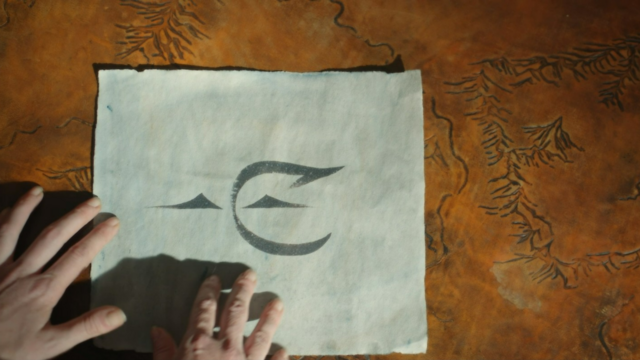
You may have noticed that of all the familiar Middle-earth locations mentioned in the show, the name Mordor is conspicuously absent--that's because it isn't actually Mordor quite yet. Galadriel notes that the symbol Sauron has been leaving is actually a map--more specifically, a map to his base in the Southlands--which we know from the Third Age is eventually his base in a hellscape called Mordor. The Orcs are already hard at work terraforming the farmland, and we can expect to see more and more of that as the show progresses.
7.) Celebrimbor's ambition
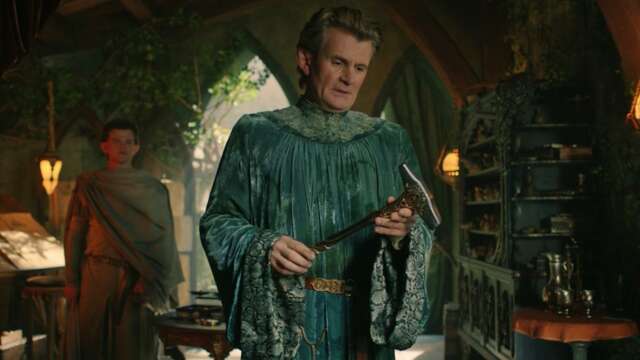
We haven't seen much of legendary Elvish smith Celebrimbor in the show--but we've seen enough to establish that the dude's got a bit of an inferiority complex. He wants to make something truly noteworthy, and he enlists Elrond's help to make it real. What neither he nor Elrond realize just yet is that this ambition is going to blow up in just about everyone's faces--Celebrimbor is being manipulated into forging the rings for Sauron. Hopefully, we'll get to see just how that plays out soon--including some scenes between Celebrimbor and the man himself, even if he's disguised at the time.
8.) Halbrand's royal lineage
Like Theo, Halbrand is a character invented for the show who seems to have a deep connection to the lore in an interesting way--but unlike Theo, this has yet to tie him directly to Sauron just yet. Instead, Halbrand is apparently a lost king of the Southlands--or at least Galadriel is convinced that he is. This is potentially important, given that there are nine rings of power that eventually need to be handed out to the kings of men, and many of those kings were never named or established within the original canon.
Marvel, Star Wars and 20th Century Studios D23 showcase: Everything announced
D23 Expo 2022 is in full swing, and day two of the ultimate Disney fan event delivered plenty of spectacular announcements and reveals for Marvel, Star Wars, and 20th Century Studios fans to enjoy.
With day one of D23 Expo 2022 unveiling new projects in the works at Pixar and Disney Animation Studios, today (September 10) was all about Disney's two biggest franchises – the Marvel Cinematic Universe (MCU) and Star Wars – and one of its most notable film studios in 20th Century.
From announcements concerning MCU Phase 4 and Marvel Phase 5, to new Star Wars movies and 20th Century Studios flicks, day two of D23 Expo 2022 largely delivered the goods. New details on superhero films, trailers for upcoming Disney Plus shows, and a a brand-new look at Avatar 2 were just the beginning, too, with a variety of surprise cast announcements also part of proceedings.
Below, we've rounded up everything that was announced during the main panel on day two of D23 Expo 2022. Use the navigation bar at the top of the page to jump to the projects you're interested in, or scroll through slowly to find out more about every announcement and reveal.
Lucasfilm: Star Wars, Willow, and Indiana Jones 5
Andor: final trailer released
Andor, the next Star Wars series to debut on Disney Plus, received a final trailer as part of D23 Expo 2022.
The 90-second teaser gives a stunning glimpse into arguably the most mature Star Wars TV show yet, but plenty of action, tense drama, and complex relationships on show in the footage.
"This is like a 12-episode film," Diego Luna, lead actor and executive producer on Andor, told D23 attendees. "It's a gigantic film." If it's half as good as it looks and sounds, we might have a new number one Star Wars show on our hands.
Andor launches with a three-episode premiere on Wednesday, September 21.
Willow: "epic" fight scenes teased and new trailer drop
Willow, the Disney Plus TV sequel to the similar titled 1988 fantasy movie from Lucasfilm, received a new trailer and some intriguing details during its brief time on stage.
Erin Kellyman, who plays Jade in the Disney Plus show, said fans can expect to see some "epic" fight scenes, while Christian Slater (Mr. Robot, Archer) was confirmed to be part of the series' cast.
Lastly, a new magical-but-foreboding trailer was debuted, which provided a better look at the adventure that Willow (Warwick Davis) and his band of followers will go on to save the world once more.
Tales of the Jedi: first trailer and release date revealed
A six-part short story series, Tale of the Jedi sees Star Wars return to its Clone Wars-style of animation.
The trailer, which provides an exciting look at what we can expect from the miniseries, looks like it'll fill in some backstory details concerning key Star Wars characters, including Ahsoka Tano and Count Dooku. According to creator Dave Filoni, three of the shorts will expand on Ahsoka's journey from her home world to the iconic Force wielder we know her to be.
Finally, an official release – Wednesday, October 26 – was confirmed for the series of shorts, which will all debut on the streamer that day.
The Bad Batch season 2: January 2023 launch confirmed
#TheBadBatch returns with a 2-episode premiere January 4, 2023. #D23ExpoSeptember 10, 2022
It's been a long time since we received any concrete news on The Bad Batch season 2. But it's been confirmed that the animated series will return to our screens on January 4, 2023. It'll get a two-episode premiere on that date, too, while the series will contain 16 episodes overall.
New Ahsoka, Skeleton Crew details revealed
Jude Law is here again (after debuting as Captain Hook yesterday) #D23Expo pic.twitter.com/sntwhkVk5gSeptember 10, 2022
More details were revealed for other forthcoming live-action Star Wars shows, such as Ahsoka and Skeleton Crew.
Per Jon Favreau, Ahsoka will be Dave Filoni's "magnum opus", while the idea for Skeleton Crew was formed during Favreau's time working on Marvel's Spider-Man movies alongside Jon Watts. Watts directed all three MCU movies for the webslinger and will be showrunner on Skeleton Crew.
A first-look image at Jude Law's character in Skeleton Crew was also revealed, which you can see above (thanks to Total Film for the screenshot). Speaking about the show, Watts simply said: "It's a show about a group of kids who get lost in the Star Wars galaxy."
The Mandalorian season 3: first trailer unveiled
Not to be outdone by its contemporaries, The Mandalorian season 3 was also part of the showcase.
Teasing what fans can expect to see from Moff Gideon, the villain of the piece, in the show's next installment, Giancarlo Esposito told attendees: "You haven't seen Moff be vulnerable before... Only you can supply yourself with the patience to find out what comes next." Sounds ominously intriguing. Meanwhile, Katte Sakhoff, who portrays Bo-Katan, revealed that she'd seen footage from season 3, calling it "crazy".
Oh and, to give us a taste about what can look forward to, a first teaser was also unveiled. Suffice to say: it looks as drama-fuelled, action-packed, and thrilling as we remember the show to be. No official release date was revealed, but the teaser confirmed that season 3 would arrive sometime in 2023.
Indiana Jones 5: first trailer debuts during showcase
INDIANA JONES footage! A big sequence during a New York ticker tape parade. A horseback chase in a subway tunnel. A train sequence. The whip versus a dozen guns. It plays.September 10, 2022
The first trailer for Indiana Jones 5 debuted at Saturday's presentation, but it's yet to make its way online.
Still, we've received some insight into what was shown. The teaser is said to contain plenty of high-octane sequences, including high-speed chases on planes, boats, and a horseback one in a subway tunnel. There's a scene where Indy uses his whip against a number of foes holding guns.
Sallah (John Rhys-Davies), Indy's friend from Raiders of the Lost Ark and The Last Crusade, is back for the fifth and final movie. Meanwhile, there'll be a couple of flashbacks to a younger Indy, played by a de-aged Harrison Ford.
Director James Mangold, iconic actor Harrison Ford, and co-star Phoebe Waller-Bridge were all in attendance to show off the movie's first teaser. Ford got notably emotional during and after it was shown, according to attendees, before he told audiences: "We have a really human story to tell, as well as a movie that'll kick your ass."
MCU: Werewolf by Night, Secret Invasion, and more
Black Panther: Wakanda Forever: exclusive footage shown

Black Panther: Wakanda Forever, the next Marvel movie set to debut in theaters, was first up during Marvel Studios' presentation.
Director Ryan Coogler was on hand to deliver some exclusive footage, with a new teaser showing a scene from the film itself. The footage shows Queen Ramonda delivering a powerful speech to the United Nations about other countries trying to steal Wakanda's stash of vibranium. It's a moment interspersed with footage of mercenaries trying to break into Wakanda laboratories to steal the precious metal, but they're halted and incapacitated by the Dora Milaje. That'll teach them.
Other footage reportedly showed Riri Williams/Ironheart flying through the sky and antagonist Namor showing off his superhuman strength in a fight against M'Baku, whose staff shatters against Namor's flexed arm. Meanwhile, there was a brief blink and you'll miss it moment featuring Michaela Coel's new character Aneka.
It's unclear if the teaser will be released online. But, with Wakanda Forever less exactly two months away from being released – it's out November 11 – hopefully we'll get to see the new trailer soon, regardless of whether this scene is posted online.
Ironheart: first teaser shown

Ryan Coogler wasn't done when the Wakanda Forever portion of the panel was over, though. The director is also an executive producer on Ironheart, Riri Williams' upcoming Disney Plus show, so he remained on stage – and was joined by co-star Anthony Ramos, no less – to tease a first look at the superhero series.
Ramos, who plays someone called Parker Robbins, aka the supervillain known as The Hood, was described by the actor as a "complex guy" with a bit of good and bad in him. He'll deal in the dark magical arts, too, which will put him on an interesting collision course with the more technology-minded Riri Williams, who is portrayed by Dominique Thorne.
Again, no word on whether this teaser will make its way online. Regardless, the show is still being filmed in Chicago and Atlanta ahead of a late 2023 release.
Ant-Man and the Wasp: Quantumania: new details and trailer teased

Ant-Man and the Wasp: Quantumania will be the first project in Marvel's Phase 5 line-up, with the film debuting in theaters in February 2023.
Speaking during the event, lead star Paul Rudd said: "This is unlike anything you’ve seen, certainly from Ant-Man and the Wasp. This thing is bananas." Rudd goes on to praise Jonathan Majors' role in the movie, with the actor continuing to play Kang the Conqueror and his many variants – the first of who we saw in Loki's season 1 finale.
Meanwhile, Marvel Studios president Kevin Feige teased Ant-Man 3 will kick Phase 5 off "in a big way" and that it'll begin the "direct line" to Avengers: The Kang Dynasty, one of three confirmed films in Marvel's Phase 6 slate.
A full trailer was shown off but, as with most Marvel D23 trailers, it hasn't been made available publicly. Lastly, Randall Park's Jimmy Woo will be part of the film's cast.
Werewolf by Night: release date finally confirmed
After months of waiting, Werewolf by Night – an upcoming MCU TV special – has an official release date: it's coming October 7.
Directed by film composer Michael Giacchino (Lightyear, multiple MCU movies), Werewolf by Night will star Gael García Bernal and Laura Donnelly, and takes inspiration from horror films shot in the 1930s and 1940s.
And, based on the special's first trailer, that's exactly the kind of retro aesthetic and mysterious tone it gives off. Shot in black and white, the teaser gives off a very old school vibe, complete with timey-wimey humor, Hitchcockian camera angles, and plenty of mature themes. There's even more than a few lashings of blood, which shows Marvel isn't averse to crossing that family feel line it's been afraid to cross since the MCU's inception.
Secret Invasion: first teaser released online
Following its debut at Marvel's Comic-Con 2022 panel, the first trailer for Secret Invasion has been publicly unveiled.
Starring Samuel L Jackson's Nick Fury, Secret Invasion will see the ex-SHIELD director and his Skrull companion Talos (Ben Mendolsohn) investigate the invasion of a secret society of Skrulls on earth.
Billed as an espionage thriller in the same vein as Captain America: The Winter Soldier – the teaser certainly gives off that vibe – Secret Invasion looks like it'll be a series full of twists and turns, with the show's major players forced to work out if they're speaking to, and working with, real MCU human characters or Skrulls masquerading as those individuals.
The teaser gives us our first looks at characters played by Olivia Colman, Emilia Clarke, and Kingsley Ben-Adir, while revealing that Cobie Smulders' Maria Hill, Don Cheadle's James Rhodes/War Machine, and Martin Freeman's Everett K Ross are part of its cast. Expect plenty of surprises from this one.
Armor Wars: the MCU show lives!
Just announced at #D23Expo, Don Cheadle will return in Marvel Studios’ Armor Wars, coming to @DisneyPlus. pic.twitter.com/Ac3nj6LYuiSeptember 10, 2022
After its no show at Marvel's Comic-Con 2022 panel, many fans had feared that the War Machine-starring Armor Wars had been put out to pasture.
Thankfully, Marvel confirmed that wasn't the case, with the series coming soon to Disney Plus. The show will reportedly follow on from the events of Secret Invasion, and see James Rhodes pursue criminals who procure some of Tony Stark's old tech. The six-part series will enter full production next year, so expect it to form part of Marvel's Phase 5 slate.
Loki season 2: new cast member announced and footage shown

There was no footage to show off for Loki season 2 – publicly, at least – which is currently filming in the UK, but there was an opportunity to reveal a new member of the Disney Plus show's cast.
Ke Huy Quan, who featured in A24's multiverse movie Everything Everywhere All at Once, has been added to the series' main cast. No word was given on who Quan is playing yet, though.
Loki season 2 will apparently connect to the whole Multiverse Saga, meaning it'll span Phases 4, 5 and 6. Talk about head-spinning!
Fantastic Four: Matt Shakman confirmed as director
It was a rumor that's done the rounds online for weeks, and Marvel finally confirmed that Matt Shakman will be director on the studio's Fantastic Four film reboot. Shakman helmed one of the best MCU TV series to date in WandaVision, so it seems that Fantastic Four will be in good hands.
Disappointingly, though, MCU head honcho Kevin Feige revealed that no cast announcements would be made just yet. That's sure to frustrate Marvel fans – Fantastic Four fans specifically – with online speculation also hinting at which actors may be cast as the iconic quartet. We'll just have to wait for more at a later date.
Echo: filming has wrapped, Wilson Fisk confirmed to wear eye mask
Marvel Studios' Echo, the spin-off series from its Hawkeye Disney Plus show, has wrapped filming. Speaking during Marvel's presentation, Kevin Feige revealed that production had ended on the upcoming Phase 5 series, which will be released in mid-2023.
The show's main cast members were in attendance to debut some of the first footage from Echo, with Vincent D'Onofrio's Wilson Fisk seen sporting an eye patch. That's from when Alaqua Cox's Maya Lopez shot him during Hawkeye's finale, so expect Fisk to be gunning for Lopez in her solo series.
The footage also teased plenty of links to Echo's Native American culture, with attendees describing it as "looking very different to what you're thinking".
Daredevil: Born Again: filming set to begin in 2023
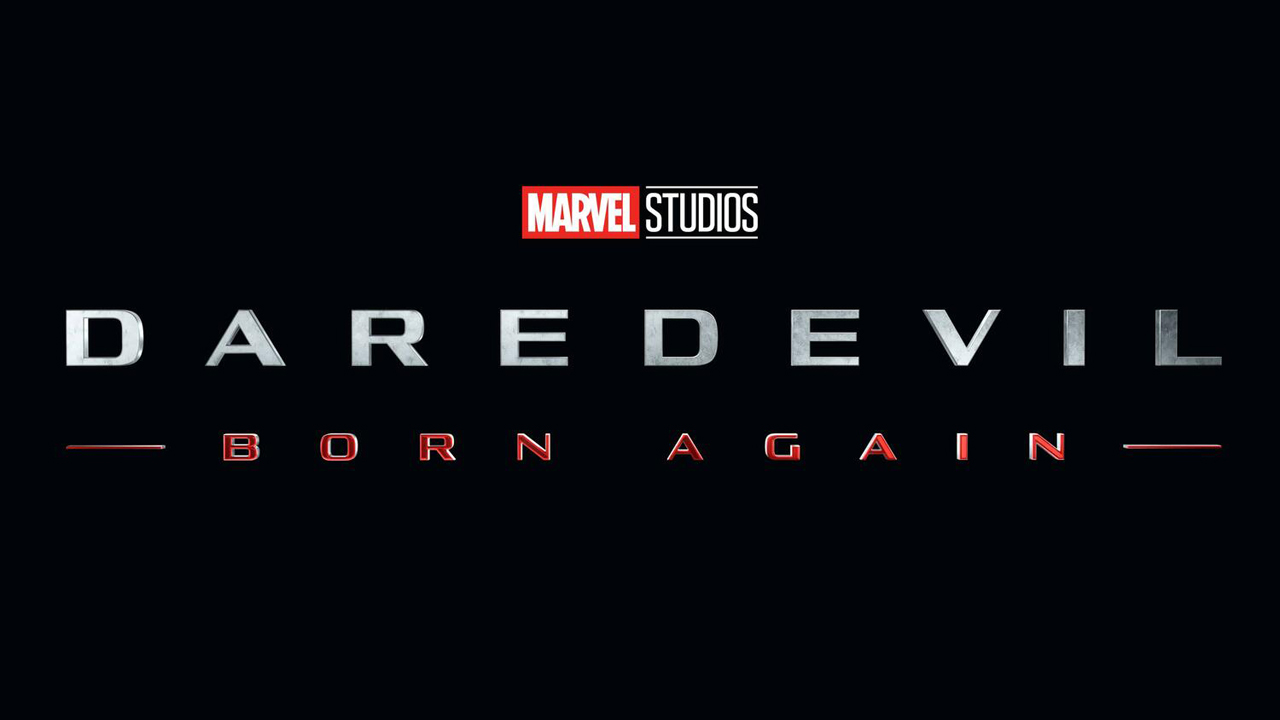
Daredevil: Born Again, the 18-part series starring Charlie Cox's masked vigilante, also got a brief update during Marvel's presentation. Cox took to the stage to confirm that the show would begin shooting in 2023 ahead of its confirmed 2024 release.
With little else to chat about, a clip from She-Hulk: Attorney at Law, which Cox's Daredevil will cameo in, was shown. It showed the two superheroes arguing about the best approach to taking out their foes, which drew plenty of laughs from the crowd.
Captain America: New World Order: new cast announcements
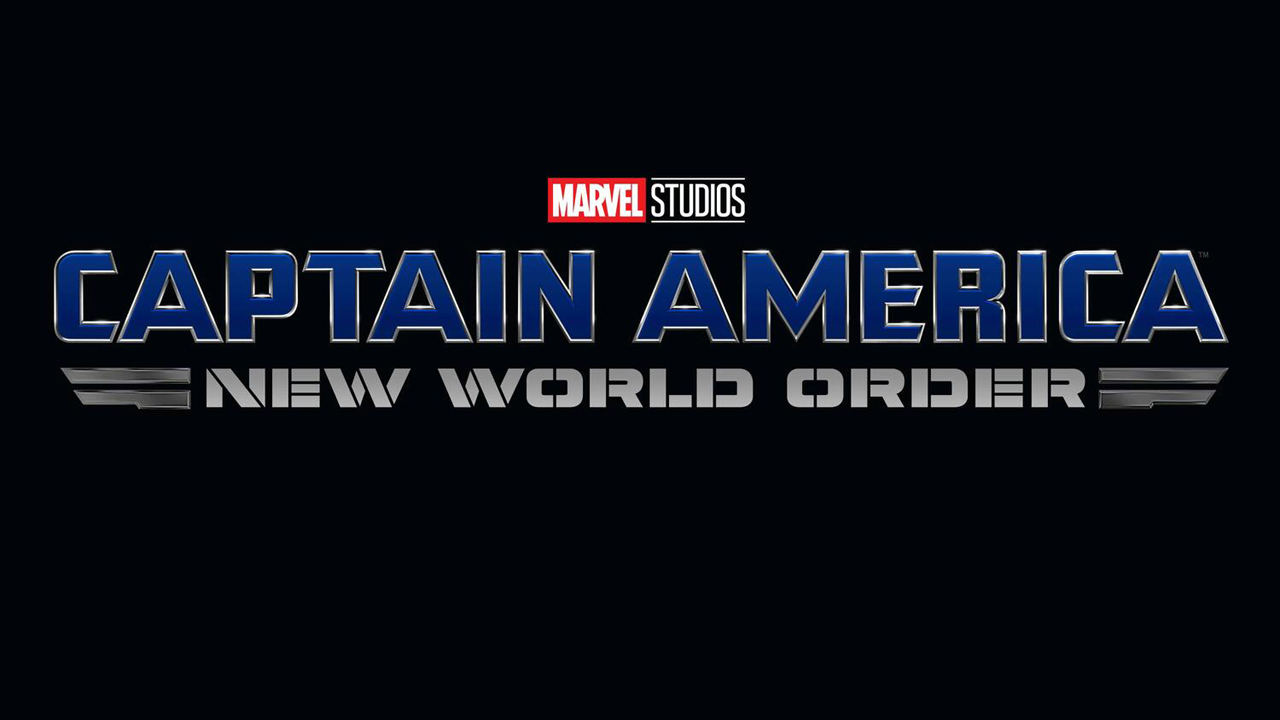
Fresh from its reveal at Comic-Con 2022, Captain America: New World Order received some more new, well, news at D23 Expo 2022.
More specifically, casting news. Danny Ramiez's Joaquin Torres, who had a supporting role in Falcon and the Winter Soldier, will have an "expanded" role in Captain America 4, which will star Anthony Mackie as the new winged Cap.
More surprising than that, though, was the revelation that Tim Blake Nelson will join Tim Roth in making his long awaited return to the MCU. Nelson, who played Samuel Sterns/The Leader in 2008's The Incredible Hulk, will play a significant part in Captain America 4. He joins Roth in returning to Marvel's juggernaut franchise, with Roth's Abomination having a role in She-Hulk's TV show.
Finally, Shira Haas (Unorthodox) has been cast as Israeli superheroine Sabra, while Carl Lumbly returns as Isaiah Bradley from Falcon and the Winter Soldier.
Thunderbolts: full cast revealed
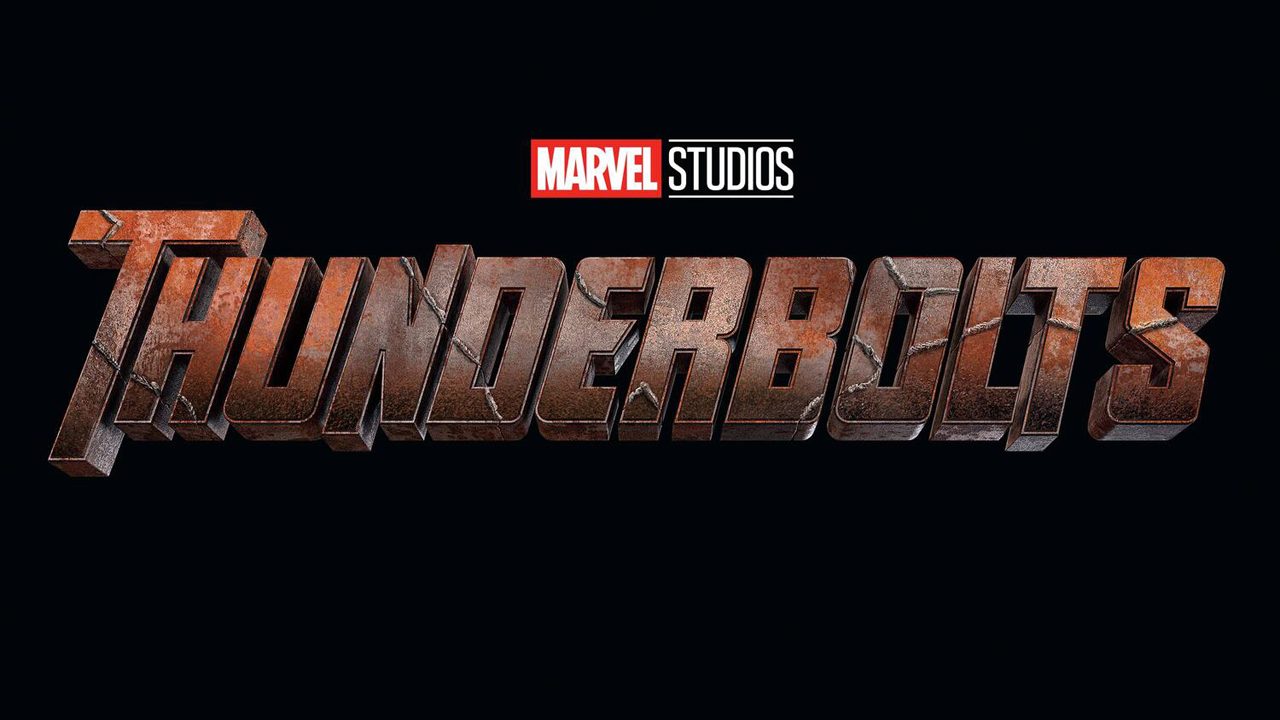
After months of speculation, the main cast for Marvel Studios' Thunderbolts movie was also unveiled.
The Thunderbolts' full line-up is: The Winter Soldier (Sebastien Stan), Yelena Belova (Florence Pugh), Red Guardian (David Harbour), Ghost (Hannah John-Kamen), Taskmaster (Olga Kurylenko), and US Agent (Russell Wyatt). The six-strong team will be led by La Contessa Valentina Allegra de la Fontaine (Julia Louis-Dreyfus).
Speaking about the line-up, Kevin Feige joked: "It tell you a lot about the team when beloved Winder Soldier is the most stable among them". Filming will begin early in 2023 ahead of the movie's July 2024 release date.
The Marvels: new footage revealed
The final part of Marvel's presentation was reserved for The Marvels, which arrives in theaters in July 2023.
All the movie's main cast members were in attendance, with Brie Larson (who plays Captain Marvel) expressing her delight at "having a team" in the all-female superhero film.
A batch of new footage was shown off during the presentation, which included a call back to Ms Marvel's post-credits stinger. The snippets shown included Zawe Ashton's unnamed antagonist wielding an accuser's hammer, plenty of body swapping between the trio, a brief glimpse at Nick Fury and Kamala Khan's family, and a small cameo from Goose the cat. It seems like the teaser went down well with viewers, so here's hoping it's a blast when it lands in cinemas next year.
20th Century: Avatar: The Way of Water
Avatar: The Way of Water: new footage revealed
Calling in from New Zealand, legendary director James Cameron brought a bunch of new Avatar: The Way of Water footage to show exclusively to D23 attendees.
Dolby 3D glasses were handed out to every member in the packed auditorium, with Cameron and company – the film's cast were also in attendance – showing off a number of beautiful looking underwater and on-land scenes from the upcoming sequel.
Sigourney Weaver, meanwhile, revealed that she'll be playing the daughter of Sulley and Neytiri in Avatar 2, who is called Kiri. "Only Jim [Cameron] is crazy enough to have written this character for me!" Weaver said on stage.
Finally, a new piece of concept art for the film, which arrives on December 16, was released online:
Pandora’s beauty awaits.Brand-new concept art has arrived for #AvatarTheWayOfWater, in theaters December 16. pic.twitter.com/EymxRYJfDDSeptember 10, 2022
And that's a wrap on the main panel on day two of D23 Expo 2022! There were a few reveals we were disappointed not to see – the lack of Fantastic Four cast announcement, little in the way of new Marvel Phase 6 projects, and no news on upcoming Star Wars films among them.
Still, we can't complain with what we've just learned about from Marvel, Lucasfilm, and 20th Century Studios. Here's hoping all of the above projects live up to expectations when they arrive on the big and small screens.
LG OLED Flex solves the flat vs curved gaming monitor dilemma
Choosing between a curved and flat gaming monitor can be difficult for gamers, but LG reckons it has the solution with its LG OLED Flex, aka LX3.
The 42-inch display can be manually adjusted from a flat screen to a curve of up to 900R. Users can essentially create their ideal arc, personalising the experience. There are twenty different levels of curvature overall. There are also two presets available via buttons on the remote control, as well as the manual options, which alter the curvature in 5-degree increments.
In a press release LG adds: “Additionally, the screen of LG OLED Flex can be tilted toward up to 10 degrees or away up to 5 degrees from the user and has a height-adjustable stand – up or down by 140 millimetres – guaranteeing ergonomic comfort for those who like to sit up, and those who like to lean back.”

The bendable screen could be a great option for PC and console users who like to go from watching a TV show to enjoying an immersive gaming session, for instance.
LG says the LG OLED Flex is a world’s first and it’s possible thanks to the backlight-free, self-lit OLED tech. The company says the same display quality and 0.1 millisecond response time is available whether the display is in a flat or curved configuration.
LG is also packing in its Alpha Gen 5 processor, shortcuts to popular gaming-adjacent apps like Twitch and YouTube, support for Dolby Atmos sound and a Multi View mode that enables users to view content from two different sources at the same time, while selecting which audio source to hear.
The built-in speakers are 40W, while the Dolby Vision HDR enabled display maxes out at 4K 120Hz with variable refresh rate and G-Sync and AMD FreeSync platform support.
LG is yet to announce the release date or recommended price for the LG OLED Flex (LX3), but we’ll keep you posted.
You might like…
The post LG OLED Flex solves the flat vs curved gaming monitor dilemma appeared first on Trusted Reviews.
Crafty cops set phantom speed traps on Waze – and drivers are slowing down

If you use the Google-owned navigation app Waze, you’ve probably tapped your break pedal once or twice after seeing after seeing the police officer icon on the map.
The crowd-sourced data provided by fellow drivers can be handy in helping you avoid those seeing flashing blue lights in your rear view mirror if you’ve been driving a bit too fast. However, now the fuzz are turning the tables.
Police in Surrey have admitted laying fake speed traps using Waze, in tweets spotted by The Guardian, and drivers are slowing down as a result. “We definitely don’t drop Police markers on Waze at random points on our patrol, nope – never” the force’s Roads Policing unit wrote on Twitter accompanied by the winking emoji.
The tweet, which remains live, referred to the tactic an “easy way to get drivers to slow down on our roads” and actually thanked Waze for including it in the app. When the obviously outcry from the Twittersphere followed, the officer running the account pointed out that the markers were “technically not false” because the units “are there at that very specific point in time”.
Well played.
We definitely don’t drop Police markers on Waze at random points on our patrol, nope – never
— Roads Policing – Surrey Police – UK (@SurreyRoadCops) August 29, 2022
An easy way to get drivers to slow down on our roads – thanks @waze. pic.twitter.com/rrv9I9LJJ6
Indeed, there’s nothing on Waze that mandates the police traps have to be stationary, the account pointed out. Still, that hasn’t stopped Twitter users citing the Computer Misuse Act and accusing the police force itself of filing false reports. The tactic might be short-lived as, the Surrey Police force itself has issued a statement saying it has not endorsed its use.
The statement reads: “While officers used this application to deter dangerous driving on our roads, this is not a tactic or policy endorsed by Surrey Police. Innovation and technology will always have a part to play in keeping our communities safe but, although well-intentioned, we know this has caused concern and undermines the trust the public has in us. Media coverage has claimed “phantom” units have been created. This is not the case. Technology has not replaced the presence of officers on our roads. We’re currently reviewing and addressing the use of this tactic.”
Are the Surrey road cops justified in turning the tables, considering the feature is ostensibly there to outfox them in the first place? Let us know @trustedreviews on Twitter.
.
The post Crafty cops set phantom speed traps on Waze – and drivers are slowing down appeared first on Trusted Reviews.
30TB Portable SSD Hits Walmart For $39 But Stay Away From It
House of the Dragon: HBO Max Crashes as Millions of Game of Thrones Fans Tune in for Series Premiere
Game of Thrones prequel House of the Dragon has crashed HBO Max. Millions of subscribers flocked to the app on Sunday for the series premiere, but many were unable to view it due to technical issues that affected at least 3,500 users.
As reported by The Hollywood Reporter, it seems that certain Amazon devices couldn’t keep up with the influx of viewers. Meanwhile, HBO Max users turned to Twitter to vent their frustrations.
“House of the Dragon is being successfully viewed by millions of HBO Max subscribers this evening,” HBO said in a statement. “We’re aware of a small portion of users attempting to connect via Fire TV devices that are having issues and are in the process of resolving for those impacted users.”
The only thing that could tear down the House of the Dragon was itself. #HOTD
— HBO Max (@hbomax) August 22, 2022
Right now, it looks as though those issues have largely been resolved. Game of Thrones fans were left stranded and frustrated last night, however, when the debut episode was officially released, only to find that they simply couldn’t watch it.
HBO Max support advised users that: “To help with the crashing issues you're experiencing, please go to any other show/movie on HBO Max, turn off subtitles/captions, and then try streaming House of the Dragon again.” This reportedly worked for some users, but others remained unable to watch. Of course, it also didn’t help those who need closed captioning to view the episode at all.
This isn't the first time Game of Thrones has caused Amazon Fire crashes as similar issues were reported during the final episodes of the original show.
House of the Dragons keeps crashing the HBO MAX app on Fire TV. Other shows don't crash the app. What is going on? I cleared cache, restarted, deleted/reloaded the app. Nothing works.
— lgbeddow (@lgbeddow) August 22, 2022
House of the Dragon is the long-awaited Game of Thrones prequel that’s had fans on the edge of their seats since it was first announced.
IGN’s review of the debut episode called it “a strong, well-cast start to the Game of Thrones spin-off. This feels very close to its predecessor in tone and content, but immediately establishes a struggle for power around an amiable, weak-willed king, and vivid new characters to fight those battles. We also have dragons, inbreeding, and resentment. It’s good to be back in backstabbing Westeros.”
Want to read more about House of the Dragon? Check out everything we know about House of the Dragon so far, and find out what we know about the Gold Cloaks.
Ryan Leston is an entertainment journalist and film critic for IGN. You can follow him on Twitter.
Raspberry Pi Cat Doorbell Listens for Meows
Janet Jackson's 1989 mega-hit 'Rhythm Nation' sonically smashes old hard drives
The "brown noise" is a legendary tone purportedly capable of causing people to lose control of their bowels when subjected to its gut-punching harmonic resonance. South Park did a whole thing on it. Turns out that the 5,400 RPM hard drives from a number of old Windows-era laptops possess a brown note of their own: Janet Jackson's 1989 mega-hit "Rhythm Nation."
According to Microsoft Software Engineer, Raymond Chen, who recounted the tale in a Microsoft Developers Blog post earlier this week, "a major computer manufacturer discovered" that playing the music video (above) would not only crash the hard drive of the laptop it was running on, but also any other similar model within earshot.
The Mitre Corporation was not amused by this newfound vulnerability, issuing it an entry in the CVE database. After a thorough investigation, the device manufacturer confirmed that the song contained one of the natural resonant frequencies of the hard drives playing the song essentially rattled the devices apart. Rather than recall untold numbers of decades-old drives, the manufacturer instead opted to develop a workaround by "adding a custom filter in the audio pipeline that detected and removed the offending frequencies during audio playback," according to Chen.
BLIND GUARDIAN's HANSI KÜRSCH Talks 'The God Machine': 'We Said It Was Time For An Intense Album'
By David E. Gehlke German power metal veterans BLIND GUARDIAN have a defined songwriting core of vocalist/lyricist Hansi Kürsch and guitarist/composer André Olbrich. The two are responsible for some of the finest epic metal numbers of the last 30-plus years and also for some of its most orchestrated...
Emily The Criminal Director John Patton Ford On Making A Throwback Crime Film [Interview]
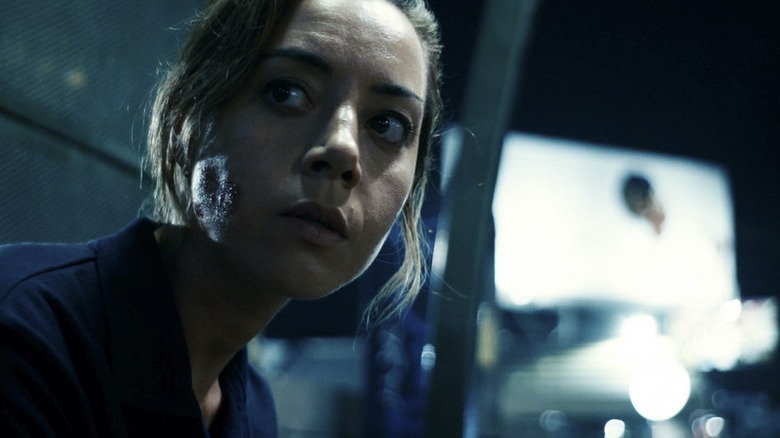
"Emily the Criminal" isn't about a glamorous life of crime. It's not about the rocking highs, the one last job, or the score to end all scores. It's a crime story about survival, with its characters just trying to make it through another crummy week. As Chris Evangelista wrote in his review, "Coupled with the prevailing sense of economic hopelessness, 'Emily the Criminal' often feels like a crime saga for the gig economy; a 'Scarface' for people who work at DoorDash, with capitalism as the film's Big Bad."
John Patton Ford is the writer and director behind the throwback crime film, which focuses more on the mundane than the highly stylized. There's no artifice -- just Emily (Aubrey Plaza) working and hustling. It's a character-driven film with Plaza making every moment feel believable and vital. It's a great performance When we caught up with Ford recently to discuss the movie, we talked about that great performance, and how he realized it was so strong, in fact, that he had to cut out scenes that didn't have her in them.
'I Haven't Seen The Whole Spectrum Of What She Has Yet'
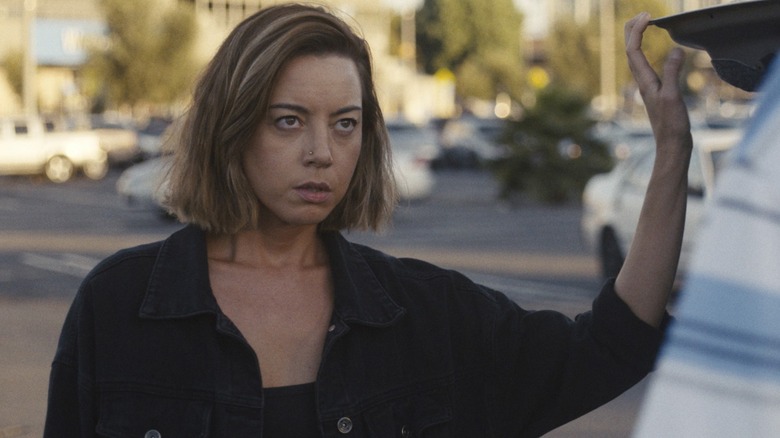
Of course, you had a voice for Emily on the page, but how did that voice change or evolve with Aubrey's performance?
Aubrey is very ... she is aggressive and determined, and when she wants something, she just goes for it in such a fearless and focused way. I think when she came on board, the character became even more narrowly focused and more driven. I leaned into that. She has so much of that naturally, that kind of seeped into the character a bit more when she came on board for certain, if that makes any sense.
It just naturally happened. I feel like we talked a lot about the character's backstory and what her relationship was like with the other people in the movie. But in terms of just what she's like, just walking around, I feel like that just happened. There's a lot of Aubrey in that, a lot of her doggedly determined nature. There's a lot of her.
What made you decide to make her from Jersey?
I think that the perennial East Coast character who's stuck in L.A. is a classic, iconic character. Especially when you move here, there's just so many people from the New York area. And either you acclimatize to what it's like living here, or you don't, and you're constantly this fish out of water. I know so many people from New Jersey. And in a way, I feel like I should be from New Jersey.
My parents were living in Manhattan in the '70s and then they moved somewhere else to have kids. And usually people moved to Long Island or Jersey, but my parents moved to South Carolina. So I'm from South Carolina, but in a weird way, I almost feel like I should have been from one of those places around the city. I feel a kinship with people who are from there.
Of the '70s crime movies "Emily the Criminal" calls to mind, you really capture the mundanity a part of them, just trying to get through the day. Was that important to you?
Yeah. So many of my favorite movies are from that era, especially a lot of Sidney Lumet movies, like "Dog Day Afternoon," or [William Friedkin's] "The French Connection." Those are the big obvious ones. So many of those movies are not afraid to test the audience and to stretch the audience and to ask the audience to empathize with the sort of person that they typically would not be asked to empathize with. In a lot of ways, those movies just had a lot more faith in the audience. This is before there were algorithms telling studio execs what to invest in. It was just individuals going, "Let's take a gamble on this." So yeah. It's a big throwback.
I thought of "Straight Time" because of the casting. In that movie, Dustin Hoffman is terrifying, and at the time, I don't think people thought of him in that light. Aubrey, she's great and has range, but was showing her in a different light appealing?
Yeah. I love so many of those movies that cast someone who you think you know, and then suddenly you see them in a totally different light. I mean, there's a joy to that. That just stands apart from the movie itself. Just that experience alone is pretty fun. I think of seeing Mickey Rourke in "The Wrestler," it was so fascinating. I was like, "Here's this guy I haven't thought of in so long, and now like he's doing this." Or Sandler in "Punch Drunk Love" is the example that we always bring up.
So yeah, meeting Aubrey and suddenly being like, "Oh, look at this complicated, colorful person. I haven't seen the whole spectrum of what she has yet. I didn't know that she had all this going on. Wouldn't it be cool to show that to an audience and to pull back the curtain on this person who we think we know?"
So every day was a nice surprise?
Every day. Every day. With her, it's never predictable. She has this profound ability to catch you off guard at all times with all things. You never quite know what you're going to get. She's, and I mean this in the most loving way, a really unsafe person. She's so unpredictable. And so every day was just a huge surprise. It's a cop-out answer, but that's really the truth.
'Usually, Crime Movies Are About Someone Who Loves Being A Criminal'
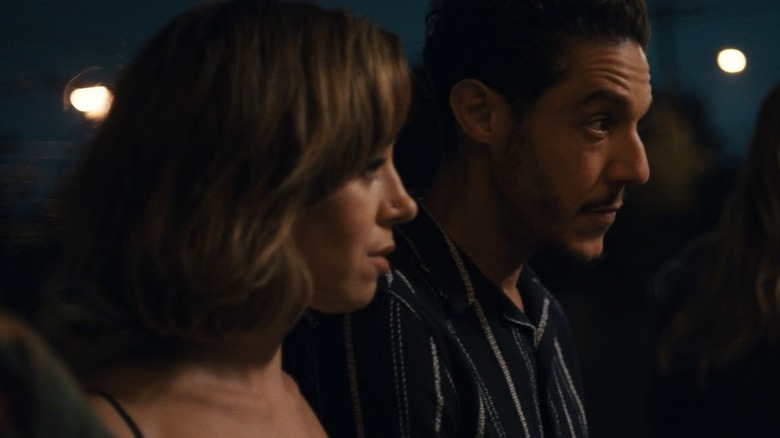
How many shooting days did you have?
I mean, we shot the movie in no time, man. We shot the whole thing in 20 days or 21 days. But believe it or not, we did shoot a lot of takes and that's because of the way that we shot it. We did it in a way that's loose enough where we were able to maximize our time. We would just shoot and shoot and shoot. Very often, we'd start the scene the way it was written, and then we'd start improvising. And then by the time we've done nine or 10 takes, it's still the same scene, but it's just way looser and way more improvised than it started off.
What about Los Angeles was important for you to capture over those 21 days?
I'd say the diversity of Los Angeles. It's something I'd never see in movies. Usually, movies about L.A. are isolated to certain ethnic worlds. We're either in east L.A. in Boyle Heights with Mexican gangsters or something, or we're in South Central or we're just with all white people in Santa Monica. And none of those things are accurate.
I mean, the movie is diverse in every single corner. You have a cross section of people in every corner. There's something like a 60% non-Anglo population. 40% of the people here, their parents are first generation. So it's just diverse in a way that's hard to compare to really anywhere in the world. I wanted to show that. I wanted my experience of the diversity of L.A. to be felt in the movie.
You first experienced the world of credit card fraud in L.A., right?
Yeah. I lived in this neighborhood 10 years ago and I knew there was some kind of crime going on. I knew there was some organized crime in the neighborhood, but I didn't know what was up. And then just one day, cover of The L.A. Times, it was this massive FBI bust. And I realized, "Oh, these are literally the dudes on my block." I read about what they'd been up to. A lot of it was unexciting. A lot of it was drugs and guns and stuff I didn't care about. But then they did this elaborate credit card fraud that I couldn't believe. It was so strange and so unique. That's how I got interested.
There really aren't many guns or drugs in this movie.
There are actually no guns in this movie. The thing is, audiences have seen that stuff so many times, that when they see it, it's just so familiar. You just tune it out. Whereas if you see something you've never seen before, suddenly you have the suspense of the unfamiliar. I wanted to capitalize on that and really make it seem so granular and so singular that you feel like, "Oh, this must be real. This isn't something that I can just categorize and put into some box that I'm already familiar with. I have to pay attention, because this is the first time I'm seeing this." That's how I wanted it.
After all the research you did for this, how much do you now know about credit card fraud?
Enough to potentially put me on some watch list, I'm sure. I'm sure someone in the FBI's listening to me on my phone right now. No, I did a lot of research and spoke to people who shall remain nameless. So I feel like I have a pretty good handle on it at this point.
Not to talk out of school, but what did you learn from some of those people you talked to?
That none of them like doing it very much. That none of them did it for pleasure or enjoyment. They all had goals. They all had really specific things that they wanted to achieve. And this was just a means to an end. I think this is something integral: Usually, crime movies are about someone who loves being a criminal. I think those people are out there, but more often than not, it's just people who really want something and they can't figure out another way to get it. They end up doing this thing that's just available and accessible.
'I Always Knew That It Was A Coming Of Age Story'
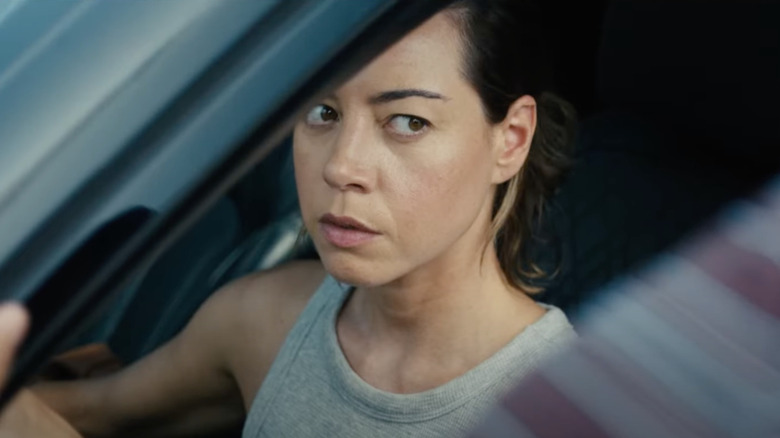
Did you always have this ending in mind for Emily?
Yeah, but it's tough to talk about without totally giving the movie away to people. I always knew that it was a coming-of-age story underneath it, and that it was about someone learning what they're good at and what they like to do and what they'll probably continue to do in the future. While you're watching the movie, you're watching a thriller and you're held in suspense, but when it's over, only then do you realize, "Oh, that was a coming-of-age story," about someone arriving at, perhaps, where they were always destined to go. And so, yeah. I always had that ending.
So you always saw it as a coming-of-age story?
No, I think the first draft, I was just writing a thriller. I was trying to figure out how to write something that I could make inexpensively and that had thrilling set pieces. It wasn't really personal in the beginning. As I continued to work on it, it became more personal and more emotional. It became more about the character.
Once Aubrey got involved, was it easy to get this made?
No, it was a lot of work. I mean, I met Aubrey four years ago when she got the script. At that point, I'd been writing the script for a couple years. And so, it took us a couple years from that point to find the money. The reality is that we live in a world where it doesn't make a ton of sense to make a movie like this that's this low budget. How do you do that? How do you sell it? How do you make money? How? The system is no longer set up to support stuff like this. So it really was a small miracle that it happened.
Correct me if I'm wrong: She's in every scene, right?
Yeah. There are actually some scenes that she's not in, but we cut them out.
When you cut the scenes that Emily wasn't in, did it just make the movie more intimate?
Yeah. And also, we just discovered that the minute you leave her, it felt like some sort of violation of a contract that had been created with the audience. Without her in the scene, it felt like, "Wait a minute, this isn't the movie that we were told we were watching." It felt just wrong. She has a certain magnetism and a certain charisma. You just want to watch her do things. You just never know what she's going to do in life and in this movie. If you got her, you might as well hold on her.
"Emily the Criminal" opens in theaters on August 12, 2022.
Read this next: The 23 Best Heist Movies Of All Time
The post Emily the Criminal Director John Patton Ford on Making a Throwback Crime Film [Interview] appeared first on /Film.
How Matt Ryan's Constantine Became The Center Of The Modern DC Universe
The DC cinematic universe, especially its live-action movies, seems quite disjointed and messy. There is no cohesive arc to the movies, no build-up to something bigger. For the last couple of years, however, that has been part of the charm, with standalone, isolated movies like "The Suicide Squad," "Birds of Prey," and "The Batman" exploring weird stories and characters in creative ways. Sure, they are not connecting into a big event film, but the sheer creativeness of each of the films makes them better than what a coherent, uniform, but formulaic universe could produce.
Reportedly, this was all supposed to somewhat change with "The Flash," a movie with a lot of aspirations. Not only is it supposed to introduce the multiverse to the DCEU, but also bring back Michael Keaton as Batman, all while also serving as a sort of reboot the same way "Flashpoint" did for the DC comics. In that storyline, Barry Allen, aka The Flash, ends up accidentally changing the course of history by going back in time and changing the past. When he goes back to undo it, it accidentally resets the entire DC universe.
While the fate of "The Flash" movie is still up in the air, it is time to recognize we don't need to wait for Barry Allen to become the center of the DC multiverse, because we already have one. The answer to every DC problem has been staring us in the face for the past eight years: make it all about Matt Ryan's Constantine.
From Humble Beginnings To A Central Role

Back in 2014, Ryan starred as John Constantine in an NBC pilot for a show built around the character created by Alan Moore, Stephen R. Bissette, Rick Veitch, and John Totleben on the pages of the iconic '80s run of "Swamp Thing." A working-class occult detective, warlock, and con man, Ryan's Constantine was praised for being a comics-accurate depiction of the Hellblazer in a show that had fantastic special effects and good use of creepy atmosphere, especially for a NBC series. But as comics-accurate as Ryan was in the titular role, the show was severely bogged down by a dull narrative and network censorship that prevented the character from smoking on screen or from being bisexual like in the source material.
The show was canceled after 13 episodes, but almost immediately there were plans to bring Constantine over to the Arrowverse. Stephen Amell and "Arrow" showrunner Marc Guggenheim campaigned to integrate Constantine into that universe as they had already introduced some mystical elements from the comics like the Lazarus Pit. Finally, in 2015, Ryan reprised the role in an episode of "Arrow" where he helps bring Sara Lance's soul back from hell, playing the same version of the character from the NBC show.
The news got even better once Ryan made an appearance on the best TV show, "Legends of Tomorrow," which then led to a series regular role and some of the best moments of that show. Constantine brought dry humor, tons of scams, and some horror flair that mixed phenomenally with the Legends' wacky slapstick, all while quickly becoming a bisexual icon on the show.
The Animated Return Of A King

Live-action is not enough for the Hellblazer, of course. Even before "Legends of Tomorrow" got tragically canceled, Ryan was already giving voice to the character on various animated projects. There was the Arrowverse-adjacent "Constantine: City of Demons" web series, but also the "Justice League Dark" movie set in the DCAU — a series of interconnected animated movies that started out as adaptations of comic book storylines but started to revolve more and more around original stories.
Most importantly, Constantine even got to be the center focus of the last DCAU movie before that continuity got rebooted, in "Justice League Dark: Apokolips War." That movie played out as a Crisis event, and was inspired by Grant Morrison's "Final Crisis." The film follows the efforts of the remaining members of the Justice League to regroup after Darkseid decimated the Earth and all its heroes. Constantine plays a major role in getting the team together and saving the world (while reuniting with his ex, King Shark!), and it is he who convinces Flash to go back in time and change the timeline, leading to a reset.
Most recently, Ryan reprised his role once again in the excellent third season of "Harley Quinn." This one is notable because the show is renowned for its disregard for DC canon and continuity, as it constantly reimagines popular characters like Nightwing, while killing established characters like Scarecrow, Penguin, Mr. Freeze, and even actual actor Billy Bob Thornton.
The Key To The DC Universe

If the whole point of "The Flash" movie being crucial to the future of the DC cinematic universe is that Barry Allen is the one that causes the plot of the movie — and the eventual reboot — to happen via time travel, then Warner Bros. Discovery can easily find a way to make Constantine the culprit. I mean, the guy is a wizard! Would it be harder to believe that a spell gone wrong causes the entire multiverse to change compared to a guy running so fast he goes back in time?
Granted, Matt Ryan reprising the role in so many projects could be just a coincidence or a cool homage to a good actor in a fantastic role, but what if it isn't? What if Matt Ryan's Constantine is the one constant in every DC universe? That would easily solve all of DC's continuity problems, and allow for arguably the single biggest crossover in film.
Forget "Infinity War," and forget "Spider-Man: No Way Home." Make a DC crisis film where you bring in all the live-action movies, the entire Arrowverse, but also the DC animated universe, and even "Harley Quinn." Hell, if you want, you can even bring in Keanu Reeves from 2005's "Constantine" for good measure and explain it as bizarro world. And if we're really shooting for the stars here, why not get Guillermo del Toro to direct the film and make the Justice League Dark movie he always wanted?
Read this next: Every DC Movie Made Prior To The DCEU Ranked From Worst To Best
The post How Matt Ryan's Constantine Became the Center of the Modern DC Universe appeared first on /Film.
























